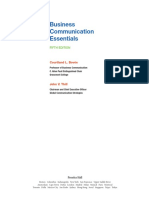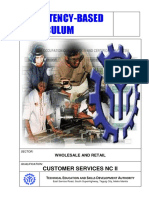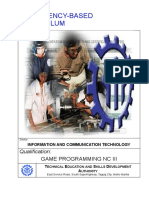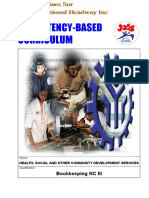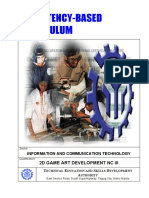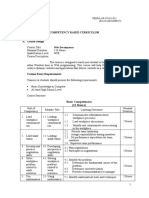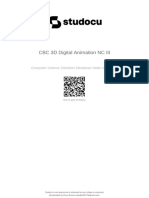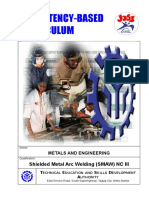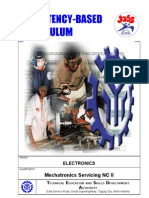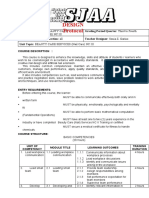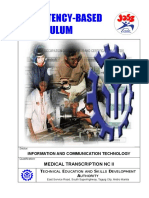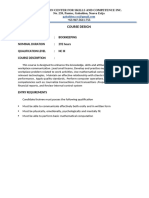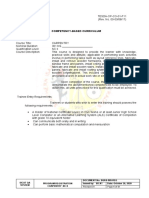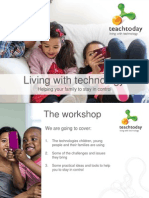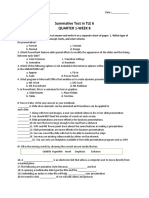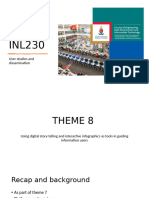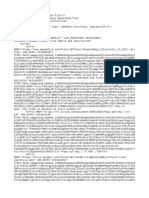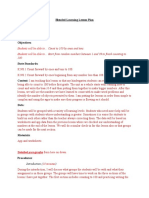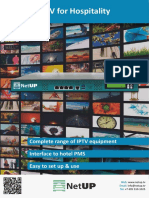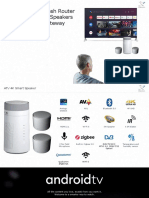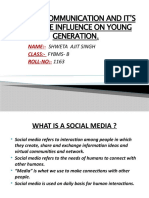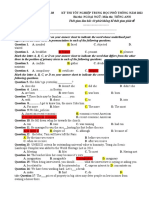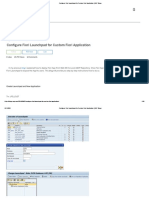Cbcvisual Graphics Design Nciii
Cbcvisual Graphics Design Nciii
Uploaded by
snsnCopyright:
Available Formats
Cbcvisual Graphics Design Nciii
Cbcvisual Graphics Design Nciii
Uploaded by
snsnOriginal Title
Copyright
Available Formats
Share this document
Did you find this document useful?
Is this content inappropriate?
Copyright:
Available Formats
Cbcvisual Graphics Design Nciii
Cbcvisual Graphics Design Nciii
Uploaded by
snsnCopyright:
Available Formats
CBCVisual Graphics Design Nciii
Visual Graphic ( Davao Medical School Foundation )
Scan to open on Studocu
Studocu is not sponsored or endorsed by any college or university
Downloaded by TGIS LA UNION (tgislaunion@gmail.com)
COMPETENCY-BASED
CURRICULUM
Sector:
INFORMATION AND COMMUNICATION TECHNOLOGY
Qualification:
VISUAL GRAPHICS DESIGN NC III
TECHNICAL EDUCATION AND SKILLS DEVELOPMENT
AUTHORITY
East Service Road, South Superhighway, Taguig City, Metro Manila
Article I.
Downloaded by TGIS LA UNION (tgislaunion@gmail.com)
TABLE OF CONTENTS
Page
A...COURSE DESIGN.....................................................................................................1-5
B. MODULES OF INSTRUCTION.............................................................................6-95
•......................................BASIC COMPETENCIES
.....................................................................................................................................6
o Leading workplace communication..............................................................7-10
o Leading small team.....................................................................................11-15
o Developing and practicing negotiation skills..............................................16-18
o Identifying/determining fundamental cause of problem.............................19-22
o Using mathematical concepts and techniques............................................23-26
o Using relevant technologies........................................................................27-30
•...................................COMMON COMPETENCIES
...................................................................................................................................31
o Applying quality standards.........................................................................32-35
o Operating a personal computer...................................................................36-41
•......................................CORE COMPETENCIES
...................................................................................................................................42
o Developing design studies..........................................................................43-55
o Creating vector graphics using a graphics application...............................56-60
o Creating raster graphics using a graphics application................................61-67
o Developing print media..............................................................................68-78
o Developing electronic media.....................................................................79-85
o Developing product packaging...................................................................86-90
o Designing booth and product/window display...........................................91-95
Downloaded by TGIS LA UNION (tgislaunion@gmail.com)
COURSE DESIGN
VISUAL GRAPHICS DESIGN NC III
Downloaded by TGIS LA UNION (tgislaunion@gmail.com)
COURSE DESIGN
COURSE TITLE : VISUAL GRAPHICS DESIGN NC III
NOMINAL DURATION : 487 Hours
COURSE DESCRIPTION :
This course is designed to enhance the knowledge, skills and attitudes of a trainee/student on
core competencies such as; Develop design studies, Create vector graphics using a graphics
application, Create raster graphics using a graphics application, Develop designs for print media,
Develop designs for electronic media, Develop designs for product packaging, Design designs for
booth and product/window display in accordance with the industry standards. It includes common
competencies such as; Apply Quality Standards, Perform Computer Operations.
It also includes basic competencies such as; Lead Workplace Communication, Lead Small
Teams, Develop and Practice Negotiation Skills, Solve Problems Related to Work Activities,
Use Mathematical Concept and Techniques and Use Relevant Technologies.
TRAINEE ENTRY REQUIREMENTS:
Trainees or students should possess the following requirements:
• can communicate either oral or written;
• must be physically and mentally fit to undergo training
• high school graduate or equivalent
• with basic computer skills; and
• must pass the aptitude and artistic/talent determination test
This list does not include specific institutional requirements such as educational attainment,
appropriate work experience, and others that may be required of the trainees by the school or training
center delivering the TVET program.
CBC Visual Graphics Design NC III -1-
Downloaded by TGIS LA UNION (tgislaunion@gmail.com)
COURSE STRUCTURE:
BASIC COMPETENCIES
(64 hours)
Units of Nominal
Competency Module Title Learning Outcomes Duration
1. Lead workplace 1.1 Leading 1.1.1 Communicate information 8 hours
communication workplace about workplace processes.
communication 1.1.2 Lead workplace discussions
1.1.3 Identify and communicate
issues arising in the
workplace
2. Lead small team 2.1 Leading small 2.1.1 Provide team leadership 8 hours
team 2.1.2 Assign responsibilities
among members
2.1.3 Set performance
expectation for team
members
2.1.4 Supervise team
performance
3. Develop and 3.1 Developing and 3.1.1 Plan negotiations 16 hours
practice practicing 3.1.2 Participate in negotiations
negotiation negotiation
skills skills
4. Solve 4.1 Identifying/ 4.1.1 Explain the analytical 8 hours
workplace determining techniques
problem related to fundamental 4.1.2 Identify the problem
work activity cause of 4.1.3 Determine the possible
problem cause/s of the problem
5. Use 5.1 Using 5.1.1 Identify mathematical tools 16 hours
mathematical mathematical and techniques to solve
concept and concept and problems.
techniques techniques 5.1.2 Apply mathematical
procedure/ solution.
5.1.3 Analyze results.
6. Use relevant 6.1 Use relevant 6.1.1 Study/select appropriate 8 hours
technologies technologies technology
6.1.2 Apply relevant technology
6.1.3 Maintain/enhance relevant
technology
CBC Visual Graphics Design NC III -2-
Downloaded by TGIS LA UNION (tgislaunion@gmail.com)
COMMON COMPETENCIES
(16 hours)
Units of Nominal
Competency Module Title Learning Outcomes Duration
1. Apply quality 1.1 Applying quality 1.1.1. Assess quality of received 8 hours
standards standards materials
1.1.2. Assess own work
1.1.3. Engage in quality
improvement
2. Operate a personal 2.1 Operating a 2.1.1. Start the computer and 8 hours
computer personal computer shutdown computer
2.1.2. Arrange and customize
desktop display/window
settings
2.1.3. Work with files and folders
(or directories)
2.1.4. Work with user application
programs
2.1.5. Print information
CORE COMPETENCIES
(405 hours)
Units of Nominal
Competency Module Title Learning Outcomes Duration
1. Develop design 1.1. Developing 1.1.1. Receive and interpret 45 hours
studies design studies design brief
1.1.2. Generate and assess ideas
1.1.3. Conduct research
1.1.4. Select media materials
1.1.5. Apply visual design and
communication techniques
1.1.6. Evaluate design
2. Create vector 2.1. Creating vector 2.1.1. Prepare work environment 75 hours
graphics using graphics using 2.1.2. Set color match between
graphics graphics monitor and printer
applications applications 2.1.3. Employ various graphics
application techniques in
producing artworks or
objects
2.1.4. Produce printer-ready
graphics
3. Create raster 3.1. Creating raster 3.1.1. Balance image quality and 75 hours
graphics using graphics using file size
graphics graphics 3.1.2. Manipulate object/images
applications applications 3.1.3. Use/Modify variable
templates for printing
3.1.4. Create raster graphics for
final media
3.1.5. Prepare graphic materials
for printing
CBC Visual Graphics Design NC III -3-
Downloaded by TGIS LA UNION (tgislaunion@gmail.com)
Units of Nominal
Competency Module Title Learning Outcomes Duration
4. Develop print 4.1. Developing 4.1.1. Review and interpret the 75 hours
media print media client brief
4.1.2. Prepare the work
environment
4.1.3. Arrange elements on page
4.1.4. Finalize and check quality
of work
4.1.5. Prepare for final media
4.1.6. Produce printer-ready
mock-up
4.1.7. Set command preferences
and color separation options
for the page
5. Develop 5.1. Developing 5.1.1. Receive and interpret the 45 hours
electronics media electronics brief
media 5.1.2. Conduct research
5.1.3. Select techniques, tools,
delivery platform, and
software/ gather materials
5.1.4. Apply visual design and
communication techniques
5.1.5. Evaluate design outcome
6. Develop product 6.1. Developing 6.1.1. Receive and interpret the 45 hours
packaging product brief
packaging 6.1.2. Develop prototype
6.1.3. Prepare design for mass/
volume production
7. Design booth and 7.1. Designing booth 7.1.1. Receive and interpret the 45 hours
product/ window and product/ brief
display window display 7.1.2. Develop design prototype
7.1.3. Produce actual booth and
product/window displays
7.1.4. Evaluate design outcome
METHODOLOGIES:
• Lecture/ discussion
• Practical exercises
• Simulation
• Demonstration
ASSESSMENT METHODS:
• Observation
• Practical demonstration
• Oral questioning
• Portfolio
CBC Visual Graphics Design NC III -4-
Downloaded by TGIS LA UNION (tgislaunion@gmail.com)
RESOURCES:
TOOLS EQUIPMENT MATERIALS
• Operating system • Computer with at • Reference Book
• Internet Browsers least 17” monitor • Adobe PDF
(Netscape Navigator, • Ergonomic computer documents
Internet Explorer, tables and chairs • Hand-outs
Mozilla, Opera) • LCD Projector • CD’s
• Relevant or • Printer • Practice materials
equivalent software • Scanner • Various printing
applications: • Digital Camera media
- Adobe Photoshop • Monitor calibrator • (e.g. photo-paper,
- Adobe Illustrator (optional) tarpaulin, etc.)
- Adobe Acrobat • CD- or DVD • Print media
- Gimp ROM/Player • Internet
- Auto CAD • CD ROMs
• Printed materials
- Books and magazines
- Newspapers
- Brochures and flyers
- Billboards and
tarpaulins
QUALIFICATION OF INTSTRUCTORS/TRAINERS:
• Must be a holder of Visual Graphic Design NC III or equivalent qualification
• Must have undergone training on Training Methodology III (TM III) or equivalent in
training/experience
• Must be computer literate
• Must be physically and mentally fit
• *Must have at least 2 years job/industry experience
*Optional. Only when required by the hiring institution.
CBC Visual Graphics Design NC III -5-
Downloaded by TGIS LA UNION (tgislaunion@gmail.com)
MODULES OF INSTRUCTIONS
BASIC COMPETENCIES
VISUAL GRAPHICS DESIGN NC III
Downloaded by TGIS LA UNION (tgislaunion@gmail.com)
UNIT OF COMPETENCY : LEAD WORKPLACE COMUNICATION
MODULE TITLE : LEADING WORKPLACE COMMUNICATION
MODULE DESCRIPTION : This module covers the knowledge, skills and attitudes
required to prepare different reports required in the workplace.
NOMINAL DURATION : 8 hours
QUALIFICATION LEVEL : NC III
SUMMARY OF LEARNING OUTCOMES:
Upon completion of this module the students/trainees will be able to:
LO1. Communicate information about workplace processes. LO2.
Lead workplace discussions.
LO3. Identify and communicate issues arising in the workplace.
CBC Visual Graphics Design NC III -7-
Downloaded by TGIS LA UNION (tgislaunion@gmail.com)
LO1. COMMUNICATE INFORMATION ABOUT WORKPLACE PROCESSES
ASSESSMENT CRITERIA:
1. Appropriate communication method is selected.
2. Multiple operations involving several topic areas are communicated.
3. Questions are used to gain extra information.
4. Correct sources of information are identified.
5. Information is selected and sequenced correctly when required.
6. Verbal and written reporting is maintained in both familiar and unfamiliar
situations.
CONTENTS:
• Method of communication
• Communication skills
• Communication tools
• Questioning techniques
CONDITIONS:
The students/trainees must be provided with the following:
• Simulated workplace environment
• Communication tools
• Variety of information’s
METHODOLOGIES:
• Discussion
• Role play
• Brainstorming
ASSESSMENT METHODS:
• Direct observation
• Interview
CBC Visual Graphics Design NC III -8-
Downloaded by TGIS LA UNION (tgislaunion@gmail.com)
LO2. LEAD WORKPLACE DISCUSSIONS
ASSESSMENT CRITERIA:
1. Response to workplace issues are sought
2. Response to workplace issues are provided when sought.
3. Constructive contributions are made to workplace discussion on such issues as
production, quality and safety.
4. Goals and aims of actions under taken in the workplace are communicated.
CONTENTS:
• Method/techniques of discussion
• How to lead discussion
• How to solicit response
CONDITIONS:
The students/trainees must be provided with the following:
• Simulated workplace environment
• Communication tools
• Variety of information’s
METHODOLOGIES:
• Discussion
• Role play
• Brainstorming
ASSESSMENT METHODS:
• Direct observation
• Interview
CBC Visual Graphics Design NC III -9-
Downloaded by TGIS LA UNION (tgislaunion@gmail.com)
LO3. IDENTIFY AND COMMUNICATE ISSUES ARISING IN THE WORKPLACE
ASSESSMENT CRITERIA:
1. Issues and problems are identified as they arise.
2. Information regarding problems and issues are organized coherently to ensure clear
and effective communication.
3. Dialog is initiated with appropriate personnel.
4. Communication problems and issues are addressed as they arises.
CONTENTS:
• Identify problems and issues
• Organizing information on problem and issues
• Relating problems and issues
• Communication barriers affecting workplace discussions.
CONDITIONS:
The students/trainees must be provided with the following:
• Simulated workplace environment
• Communication tools
• Variety of information’s
METHODOLOGIES:
• Discussion
• Role play
• Brainstorming
ASSESSMENT METHODS:
• Direct observation
• Interview
CBC Visual Graphics Design NC III - 10 -
Downloaded by TGIS LA UNION (tgislaunion@gmail.com)
UNIT OF COMPETENCY : LEAD SMALL TEAM
MODULE TITLE : LEADING SMALL TEAM
MODULE DESCRIPTION : This module covers the knowledge, skills and attitudes
required to lead small team including setting and maintaining team
and individual performance standard.
NOMINAL DURATION : 8 hours
CERTIFICATION LEVEL : NC III
SUMMARY OF LEARNING OUTCOMES:
Upon completion of this module the students/trainees will be able to: LO1.
Provide team leadership.
LO2. Assign responsibilities among members.
LO3. Set performance expectation for team members. LO4.
Supervise team performance.
CBC Visual Graphics Design NC III - 11 -
Downloaded by TGIS LA UNION (tgislaunion@gmail.com)
LO1. PROVIDE TEAM LEADERSHIP
ASSESSMENT CRITERIA:
1. Work requirements are identified and prescribed to members.
2. Reasons for instructions and requirements are properly disseminated to team
members.
3. Team members questions, problems, concerns are recognized, discussed and dealt
accordingly.
CONTENTS:
• Communication skills required for leading small team
• Skills and techniques in promoting team building
• Negotiating skills
• Up to date dissemination of instruction and requirements to members.
• Art of listening and treating individual team members concern
CONDITIONS:
The students/trainees must be provided with the following:
• Learning materials
- team building manual
- catalogues
- brochures
• Simulated team
METHODOLOGIES:
• Traditional/lecture
• Demonstration
• Case studies
ASSESSMENT METHODS:
• Direct observation
• Interview
CBC Visual Graphics Design NC III - 12 -
Downloaded by TGIS LA UNION (tgislaunion@gmail.com)
LO2. ASSIGN RESPONSIBILITIES AMONG MEMBERS
ASSESSMENT CRITERIA:
1. Duties and responsibilities are allocated in respect to the skills, knowledge and
attitudes of every team member.
2. Duties are allocated having regard to individual preference, domestic and
personal considerations.
3. Duties and responsibilities of each member are properly identified and defined.
CONTENTS:
• Duties and responsibilities of each team member
• Skills in identifying individual skills ,knowledge and attitude as basis for allocating
responsibilities
• Knowledge in identifying each team member duties and responsibilities
CONDITIONS:
The students/trainees must be provided with the following:
• Learning materials
- relevant legal requirements
- manuals
METHODOLOGIES:
• Traditional /lecture
• Demonstration
ASSESSMENT METHODS:
• Direct observation
• Interview
CBC Visual Graphics Design NC III - 13 -
Downloaded by TGIS LA UNION (tgislaunion@gmail.com)
LO3. SET PERFORMANCE EXPECTATION FOR TEAM MEMBERS
ASSESSMENT CRITERIA:
1. Performance expectations are established based on client needs and according to
assigned requirements.
2. Performance expectations are based on individual team member’s duties and
responsibilities.
3. Performance expectations are discussed and disseminated to individual team
member.
CONTENTS:
• Knowledge and skills in setting individual performance target/expectation
• Team members duties and responsibilities
• Employee policies and procedures
• Defining performance expectations criteria
CONDITIONS:
The students/trainees must be provided with the following:
• Performance expectation worksheet
• Relevant legal requirements
METHODOLOGIES:
• Traditional /lecture
• Demonstration
• Case studies
ASSESSMENT METHODS:
• Direct observation
• Interview
CBC Visual Graphics Design NC III - 14 -
Downloaded by TGIS LA UNION (tgislaunion@gmail.com)
LO4. SUPERVISE TEAM PERFORMANCE
ASSESSMENT CRITERIA:
1. Monitor team member’s performance in respect to the defined performance
criteria.
2. Provide team members with feedback, positive support and advice on strategies to
overcome any difficulties.
3. Inform team members of any changes in the priority allocated to assignment or task.
4. Provide communication follow-up on all issues affecting the team.
CONTENTS:
• Knowledge and skills in monitoring team member performance
• Monitoring team operation to ensure client needs and satisfaction
• Methods of monitoring performance
• Informal/formal counselling skills
CONDITIONS:
The students/trainees must be provided with the following:
• Performance expectation worksheet
• Relevant legal requirements
METHODOLOGIES:
• Traditional /lecture
• Demonstration
• Modular
ASSESSMENT METHODS:
• Written examination
• Direct observation
CBC Visual Graphics Design NC III - 15 -
Downloaded by TGIS LA UNION (tgislaunion@gmail.com)
UNIT OF COMPETENCY : DEVELOP AND PRACTICE NEGOTIATION SKILLS
MODULE TITLE : DEVELOPING AND PRACTICING NEGOTIATION SKILLS
MODULE DESCRIPTION : This module covers the knowledge, skills and attitudes
required in planning and participating in negotiations.
NOMINAL DURATION : 16 hours
CERTIFICATION LEVEL : NC III
SUMMARY OF LEARNING OUTCOMES:
Upon completion of this module the students/trainees will be able to: LO1.
Plan negotiations
LO2. Participate in negotiations.
CBC Visual Graphics Design NC III - 16 -
Downloaded by TGIS LA UNION (tgislaunion@gmail.com)
LO1. PLAN NEGOTIATIONS
ASSESSMENT CRITERIA:
1. Information on preparing for negotiation is identified and included in the plan
2. Information on creating non verbal environments for positive negotiating is
identified and included in the plan
3. Information on active listening is identified and included in the plan
4. Information on different questioning techniques is identified and included in the plan
5. Information is checked to ensure it is correct and up-to- date
CONTENTS:
• Codes of practice and guidelines for the organization
• Organizations policy and procedures for negotiations
• Decision making and conflict resolution strategies procedures
• Problem solving strategies on how to deal with unexpected questions and
attitudes during negotiation
• Interpersonal skills to develop rapport with other parties
• Observation skills
• Negotiation skills
CONDITIONS:
The students/trainees must be provided with the following:
• Room with facilities necessary for the negotiation process
• Human resources (negotiators)
• Learning materials
- team building manual
- catalogues
- brochures
• Simulated team
METHODOLOGIES:
• Traditional/lecture
• Demonstration
• Case studies
ASSESSMENT METHODS:
• Direct observation
• Interview
CBC Visual Graphics Design NC III - 17 -
Downloaded by TGIS LA UNION (tgislaunion@gmail.com)
LO2. PARTICIPATE IN NEGOTIATIONS
ASSESSMENT CRITERIA:
1. Criteria for successful outcome are agreed upon by all parties
2. Desired outcome of all parties are considered
3. Appropriate language is used throughout the negotiation
4. A variety of questioning techniques are used
5. The issues and processes are documented and agreed upon by all parties
6. Possible solutions are discussed and their viability assessed
7. Areas for agreement are confirmed and recorded
8. Follow-up action is agreed upon by all parties
CONTENTS:
• Decision making and conflict resolution strategies procedures
• Problem solving strategies on how to deal with unexpected questions and
attitudes during negotiation
• Flexibility
• Empathy
• Interpersonal skills to develop rapport with other parties
• Communication skills (verbal and listening)
• Observation skills
• Negotiation skills
CONDITIONS:
The students/trainees must be provided with the following:
• Room with facilities necessary for the negotiation process
• Human resources (negotiators)
• Learning materials
- team building manual
- catalogues
- brochures
• Simulated team
METHODOLOGIES:
• Traditional/lecture
• Demonstration
• Case studies
ASSESSMENT METHODS:
• Direct observation
• Interview
CBC Visual Graphics Design NC III - 18 -
Downloaded by TGIS LA UNION (tgislaunion@gmail.com)
UNIT OF COMPETENCY : SOLVE PROBLEM RELATED TO WORK ACTIVITIES
MODULE TITLE : IDENTIFYING / DETERMINING FUNDAMENTAL CAUSE
OF PROBLEM
MODULE DESCRIPTION : This module expresses the competency required to apply
problem solving techniques to identify/determine
fundamental cause problem.
NOMINAL DURATION : 8 hours
QUALIFICATION LEVEL : NC III
SUMMARY OF LEARNING OUTCOMES:
Upon completion of this module the students/trainees will be able to: LO1.
Explain the analytical techniques.
LO2. Identify the problem.
LO3. Determine the possible cause /s of the problem.
CBC Visual Graphics Design NC III - 19 -
Downloaded by TGIS LA UNION (tgislaunion@gmail.com)
LO1. EXPLAIN THE ANALYTICAL TECHNIQUES
ASSESSMENT CRITERIA:
1. Importance and application of analytical techniques are explained.
2. Analytical techniques such as brainstorming, cause and effects diagrams,
PARETO analysis, SWOT analysis, GANT chart, PERT CPM & graphs, and
scatter grams are defined.
CONTENTS:
• Observation, investigation & analytical techniques
• Brainstorming
• Cause and effect diagrams
• PARETO analysis
• SWOT analysis
• GANT chart
• PERT CPM & graph
• SCATTERGRAMS
CONDITIONS:
The students/trainees must be provided with the following:
• Courseware
• Learning materials/guides
• Computer
• OHP
METHODOLOGIES:
• Direct observation
• Simulation /role playing
• Case studies
ASSESSMENT METHODS:
• Written
• Practical/performance test
CBC Visual Graphics Design NC III - 20 -
Downloaded by TGIS LA UNION (tgislaunion@gmail.com)
LO2. IDENTIFY THE PROBLEM
ASSESSMENT CRITERIA:
1. Variances are identified from normal operating parameters and product quality.
2. Extent, cause, and nature of the problem are defined based on observation,
investigation and analytical techniques.
3. Problems are clearly stated and specified.
CONTENTS:
• Normal operating parameters & product quality
• Identifying & clarifying the nature of problem
• Application of analytical techniques
CONDITIONS:
The students/trainees must be provided with the following:
• Courseware
• Learning materials/guides
• Computer
• OHP
METHODOLOGIES:
• Direct observation
• Simulation /role playing
• Case studies
ASSESSMENT METHODS:
• Written
• Practical/performance test
CBC Visual Graphics Design NC III - 21 -
Downloaded by TGIS LA UNION (tgislaunion@gmail.com)
LO3. DETERMINE THE POSSIBLE CAUSE/S OF THE PROBLEM
ASSESSMENT CRITERIA:
1. Possible cause/s of problem are identified based on experience & the use of
problem solving tools/analytical techniques.
2. Possible cause statements are developed.
3. Fundamental causes are explained.
CONTENTS:
• Non-routine process and quality problems
• Teamwork and work allocation problem
• Safety and emergency situations and incidents
CONDITIONS:
The students/trainees must be provided with the following:
• Courseware
• Learning materials/guides
• Computer
• OHP
METHODOLOGIES:
• Direct observation
• Simulation /role playing
• Case studies
ASSESSMENT METHODS:
• Written
• Practical/performance test
CBC Visual Graphics Design NC III - 22 -
Downloaded by TGIS LA UNION (tgislaunion@gmail.com)
UNIT OF COMPETENCY : USE MATHEMATICAL CONCEPTS AND TECHNIQUES
MODULE TITLE : USING MATHEMATICAL CONCEPTS AND TECHNIQUES
MODULE DESCRIPTION : This unit covers the knowledge, skills and attitudes required in
the application of mathematical concepts and techniques.
NOMINAL DURATION : 16 hours
QUALIFICATION LEVEL : NC III
SUMMARY OF LEARNING OUTCOMES:
Upon completion of the module, the learner/students must be able to: LO1.
Identify mathematical tools and techniques to solve problems.
LO2. Apply mathematical procedure/solution.
LO3. Analyze results.
CBC Visual Graphics Design NC III - 23 -
Downloaded by TGIS LA UNION (tgislaunion@gmail.com)
LO1. IDENTIFY MATHEMATICAL TOOLS AND TECHNIQUES TO SOLVE
PROBLEMS
ASSESSMENT CRITERIA:
1. Problem areas based on given condition are identified.
2. Mathematical techniques based on the given problem are selected.
CONTENTS:
• Four Fundamental Operations
• Steps in solving a problem
• Standard formulas
• Conversion
• Measurement
CONDITION:
The students/learners must be provided with the following:
• Manuals
• Hand-outs
• Problem set
• Conversion table
• Table of formulas
• Measuring tools
METHODOLOGIES:
• Lecture
• Self-pace
• Group discussion
ASSESSMENT METHODS:
• Written
• Demonstration
CBC Visual Graphics Design NC III - 24 -
Downloaded by TGIS LA UNION (tgislaunion@gmail.com)
LO2. APPLY MATHEMATICAL PROCEDURE / SOLUTION
ASSESSMENT CRITERIA:
1. Mathematical techniques based on the problem identified are applied.
2. Mathematical computations are performed to the level of accuracy required for the
problem.
3. Results of mathematical computation based on job requirements is determined and
verified.
CONTENTS:
• Problem-based questions
• Estimation
• Use of mathematical tools and standard formulas
• Mathematical techniques
CONDITION:
The students/learners must be provided with the following:
• Manuals
• Hand-outs
• Calculator
• Measuring tools/devices
• Case problems
METHODOLOGIES:
• Lecture
• Self-pace
• Group discussion
• Practical work approach
ASSESSMENT METHODS:
• Written
• Oral interview
CBC Visual Graphics Design NC III - 25 -
Downloaded by TGIS LA UNION (tgislaunion@gmail.com)
LO3. ANALYZE RESULTS
ASSESSMENT CRITERIA:
1. Results of application based on expected and required specifications and
outcome is reviewed.
2. Appropriate action in case of error is applied.
CONTENTS:
• Four Fundamental Operations
• Steps in solving a problem
• Standard formulas
• Conversion
• Measurement
CONDITION:
The students/learners must be provided with the following:
• Manuals
• Hand-outs
• Problem set
• Conversion table
• Table of formulas
• Measuring tools
METHODOLOGIES:
• Lecture
• Self-pace
• Group discussion
• Research study
ASSESSMENT METHODS:
• Written
• Oral
CBC Visual Graphics Design NC III - 26 -
Downloaded by TGIS LA UNION (tgislaunion@gmail.com)
UNIT OF COMPETENCY : USE RELEVANT TECHNOLOGIES
MODULE TITLE : USING RELEVANT TECHNOLOGIES
MODULE DESCRIPTION : This unit covers the knowledge, skills and attitudes required
in selecting, sourcing and applying appropriate and affordable
technologies in the workplace.
NOMINAL DURATION : 8 hours
QUALIFICATION LEVEL NC III
SUMMARY OF LEARNING OUTCOMES:
Upon completion of the module, the learner/students must be able to: LO1.
Study / select appropriate technology
LO2. Apply relevant technology.
LO3. Maintain / enhance relevant technology
CBC Visual Graphics Design NC III - 27 -
Downloaded by TGIS LA UNION (tgislaunion@gmail.com)
LO1. STUDY / SELECT APPROPRIATE TECHNOLOGY
ASSESSMENT CRITERIA:
1. Appropriate technology is studied based on work requirements.
2. Appropriate technology is identified and selected based on work requirements.
CONTENTS:
• Machineries/ equipment and their application
• Software/ programs
CONDITION:
The students/learners must be provided with the following:
• Manuals
• Hand-outs
• Multimedia
• Video tape
• Brochures
• CD’s
• Internet access
• Computer
METHODOLOGIES:
• Lecture
• Self-pace
• Group discussion
• Film showing
ASSESSMENT METHODS:
• Written
• Interview
CBC Visual Graphics Design NC III - 28 -
Downloaded by TGIS LA UNION (tgislaunion@gmail.com)
LO2. APPLY RELEVANT TECHNOLOGY
ASSESSMENT CRITERIA:
1. Relevant technology is used in carrying out function based on work requirements.
2. Applicable software and hardware is used as per job requirement.
3. Management concept are observed as per established industry practices.
CONTENTS:
• Office technology
• Industrial technology
• System technology
• Information technology
• Training technology
• Different software / Hardware
• 5S (Proper House Keeping)
CONDITION:
The students/learners must be provided with the following:
• Manuals
• Hand-outs
• Multimedia
• Video tape
• Brochures
• CD’s
• Internet access
• Computer
METHODOLOGIES:
• Lecture
• Self-pace
• Group discussion
• Film showing
ASSESSMENT METHODS:
• Written
• Interview
CBC Visual Graphics Design NC III - 29 -
Downloaded by TGIS LA UNION (tgislaunion@gmail.com)
LO3. MAINTAIN / ENHANCE RELEVANT TECHNOLOGY
ASSESSMENT CRITERIA:
1. Maintenance of technology is applied in accordance with the industry standard
operating procedure, manufacturer’s operating guidelines and occupational health and
safety procedure
2. Updating of technology is maintained through continuing education or training in
accordance with job requirement.
3. Appropriate action for technology failure/ defect is immediately reported to the
concerned/ responsible person or section.
CONTENTS:
• Corrective and preventive maintenance
• Upgrading of technology
• Communication Skills
• Organizational set–up / work flow
CONDITION:
The students/learners must be provided with the following:
• Manuals
• Hand-outs
• Multimedia
• Video tape
• Brochures
• CD’s
• Internet access
• Computer
METHODOLOGIES:
• Lecture
• Self-pace
• Group discussion
• Film showing
ASSESSMENT METHODS:
• Written
• Interview
CBC Visual Graphics Design NC III - 30 -
Downloaded by TGIS LA UNION (tgislaunion@gmail.com)
MODULES OF INSTRUCTIONS
COMMON COMPETENCIES
VISUAL GRAPHICS DESIGN NC III
Downloaded by TGIS LA UNION (tgislaunion@gmail.com)
UNIT OF COMPETENCY : APPLY QUALITY STANDARDS
MODULE TITLE : APPLYING QUALITY STANDARDS
MODULE DESCRIPTION : This module covers the knowledge, skills, attitudes and
values needed to apply quality standards in the workplace. The
unit also includes the application of relevant safety procedures
and regulations, organization procedures and customer
requirements.
NOMINAL DURATION : 8 hours
QUALIFICATION LEVEL : NC III
SUMMARY OF LEARNING OUTCOMES:
Upon completion of this module, the trainee/student must be able to:
LO1. Assess quality of received materials LO2.
Assess own work
LO3. Engage in quality improvement
CBC Visual Graphics Design NC III - 32 -
Downloaded by TGIS LA UNION (tgislaunion@gmail.com)
LO1. ASSESS QUALITY OF RECEIVED MATERIALS
ASSESMENT CRITERIA:
1. Work instruction obtained and work carried out in accordance with standard
operating procedures.
2. Received materials checked against workplace standards and specifications.
3. Faulty materials related to work are identified and isolated
4. Faults and any identified causes recorded and or reported to the supervisor
concerned in accordance with workplace procedures
5. Faulty materials are replaced in accordance with workplace procedures
CONTENTS:
• Reading skills required to interpret work instruction
• Workplace standards and specifications
• Procedures in obtaining and carrying out work instructions
• Quality checking procedures
• Fault identification and reporting
• Safety and environmental aspects of production process
• Carry out work in accordance with policies and procedures
CONDITIONS:
Students/ trainees must be provided with the following:
• Work instructions
• Manuals (Operation Manual of the company / Manufacturer’s Instruction / Service
Manual)
• Company / Workplace standards and specifications
METHODOLOGIES:
• Lecture-demonstration
• Self-paced instruction
• Group discussion
ASSESSMENT METHODS:
• Hands-on
• Direct observation
• Practical demonstration
CBC Visual Graphics Design NC III - 33 -
Downloaded by TGIS LA UNION (tgislaunion@gmail.com)
LO2. ASSESS OWN WORK
ASSESMENT CRITERIA:
1. Documentation relative to quality within the company identified and used
2. Completed work checked against workplace standards and specifications
3. Errors are identified and isolated
4. Information on the quality and other indicators of production procedures recorded in
accordance with workplace procedures
5. In cases of deviation from specific quality standards, causes documented and reported
in accordance with the workplace’s standard operating procedures.
CONTENTS:
• Communication skills needed to interpret and apply defined work procedures
• Identifying errors (deviation from customer and or organization requirements)
CONDITIONS:
Students/ trainees must be provided with the following:
• Organization work procedures
• Manufacturer’s Instruction Manual
• Customer requirements
• Other forms
METHODOLOGIES:
• Lecture-demonstration
• Self-paced instruction
• Group discussion
ASSESSMENT METHODS:
• Hands-on
• Direct observation
• Practical demonstration
CBC Visual Graphics Design NC III - 34 -
Downloaded by TGIS LA UNION (tgislaunion@gmail.com)
LO3. ENGAGE IN QUALITY IMPROVEMENT
ASSESMENT CRITERIA:
1. Process improvement procedures participated in relative to workplace
assignment
2. Work carried out in accordance with process improvement procedures
3. Performance of operation or quality of product of service to ensure customer
satisfaction monitored
CONTENTS:
• Relevant production processes, materials and products
• Safety and environmental aspects of production processes
• Critical thinking
• Quality improvement processes
CONDITIONS:
Students/ trainees must be provided with the following:
• Organization work procedures
• Manufacturer’s Instruction Manual
• Customer requirements
• Other forms
METHODOLOGIES:
• Lecture-demonstration
• Self-paced instruction
• Group discussion
ASSESSMENT METHODS:
• Hands-on
• Direct observation
• Practical demonstration
CBC Visual Graphics Design NC III - 35 -
Downloaded by TGIS LA UNION (tgislaunion@gmail.com)
UNIT OF COMPETENCY : OPERATE A PERSONAL COMPUTER
MODULE TITLE : OPERATING A PERSONAL COMPUTER
MODULE DESCRIPTOR : This module defines the competency required to operate a
personal computer by: starting the PC, logging in, using and
working with files, folders and programs, saving work, and closing
down the PC
NOMINAL DURATION : 8 hours
QUALIFICATION LEVEL : NC III
SUMMARY OF LEARNING OUTCOMES:
Upon completion of this module, the trained student must be able to: LO1.
Start and shutdown computers
LO2. Arrange and customize desktop/windows setting LO3.
Work with files and folders (or directories)
LO4. Work with user application programs LO5.
Print information
CBC Visual Graphics Design NC III - 36 -
Downloaded by TGIS LA UNION (tgislaunion@gmail.com)
LO1. START AND SHUTDOWN COMPUTERS
ASSESSMENT CRITERIA:
1. The peripheral devices are connected as stated in operating manual.
2. Power is checked and the computer and peripheral devices are switched on as shown
in computer manual.
3. Logging in or logging off is done in accordance with the existing setup.
4. The operating system features and functions are accessed and navigated as
demonstrated
a. .
5. Hardware configuration and other system features are checked as stated in
procedure
6. .
7. All open application programs are closed according to computer manual.
8. Computer and peripheral devices are shutdown according to procedure.
CONTENTS:
• Connecting of wires and peripheral devices
• Switching of powers and peripheral devices
• Proper logging in and logging off procedure
• Operating System are properly work
• Saving and closing application programs.
• Computer unit is properly shutdown
CONDITIONS:
Students/ trainees must be provided with the following.
• Computer set / Workstations
• Connection of wires / peripheral devices
• Lists / Pictures of Computer Hardware and peripheral devices
• Media / LCD / TV 32 inches
• Instructional Materials
• Minutes/Agendas
METHODOLOGIES:
• Self–paced
• Demonstration
• Discussion
ASSESSMENT METHODS:
• Direct observation
• Demonstration of skills
• Evaluation
• Interview
CBC Visual Graphics Design NC III - 37 -
Downloaded by TGIS LA UNION (tgislaunion@gmail.com)
LO2. ARRANGE AND CUSTOMIZE DESKTOP/WINDOWS SETTING
ASSESSMENT CRITERIA:
1. The desktop screen or Windows elements are changed as needed in manual
procedure
2. Desktop icons are added, renamed, moved, copied or deleted in accordance to
procedure
3. The online help functions are accessed or used as needed instructional materials
4. Desktop icons of application programs are selected, opened and closed as shown
in manual procedure
5. Properties of icons are displayed as stated in procedure
6. Computer or desktop settings are saved and restored based on the existing setup
CONTENTS:
• The desktop are screen are modified
• Manipulating of desktop
• Accessing and using the online help functions
• Opening and closing of selected desktop icons
• Presentation of icons properties
• Restoring of computer desktop
CONDITIONS:
Students/ trainees must be provided with the following.
• Computer set / Workstations
• LAN and Internet connections
• Media / LCD / TV 32 inches
• Diskettes, CD-RW, Flash Drive, Zip Drive
• Instructional materials
• Minutes/Agendas
METHODOLOGIES:
• Self–paced
• Demonstration
• Discussion
ASSESSMENT METHODS:
• Direct observation
• Demonstration of skills
• Evaluation
• Interview
CBC Visual Graphics Design NC III - 38 -
Downloaded by TGIS LA UNION (tgislaunion@gmail.com)
CBC Visual Graphics Design NC III - 39 -
Downloaded by TGIS LA UNION (tgislaunion@gmail.com)
LO3. WORK WITH FILES AND FOLDERS (OR DIRECTORIES)
ASSESSMENT CRITERIA:
1. A file or folder is created, opened, moved, renamed, copied or restored as shown in
manual procedure
2. Details and properties of files and folders are displayed or viewed with the
existing setup
3. Various files are organized for easy lookup and use as shown in computer
manual procedure
4. Files and information are searched as stated in instructional material
5. Disks are checked, erased or formatted as necessary with the following manual
procedure
CONTENTS:
• Manipulating of file or folder
• Restoring of files
• Viewing of files and folders
• Organizing of different files
• Searching of files and information
• Manipulating of disks
CONDITIONS:
Students/ trainees must be provided with the following.
• Computer set / Workstations
• Application programs (software)
• Media / LCD / TV 32 inches
• Diskettes, CD-RW, Flash Drive, Zip Drive
• Instructional Materials
• Minutes/Agendas
METHODOLOGIES:
• Self–paced
• Demonstration
• Discussion
ASSESSMENT METHODS:
• Direct observation
• Demonstration of skills
• Evaluation
• Interview
CBC Visual Graphics Design NC III - 40 -
Downloaded by TGIS LA UNION (tgislaunion@gmail.com)
LO4. WORK WITH USER APPLICATION PROGRAMS
ASSESSMENT CRITERIA:
1. Application programs are added, changed, removed or run as followed in
computer manual procedure
2. User software or application program are installed, updated and upgraded as stated
in manual procedure
3. Information/data are moved between documents or files in accordance to the
instructional materials
CONTENTS:
• Manipulating of application programs
• Updating and upgrading user software
• Moving of documents
CONDITIONS:
Students/ trainees must be provided with the following.
• Computer set / Workstations
• Documents detailing style guide / policy
• Application programs (software)
• Media / LCD / TV 32 inches
• Diskettes, CD-RW, Flash Drive, Zip Drive
• Hands – On materials / Instructional materials
• Minutes/Agendas
METHODOLOGIES:
• Self–paced
• Demonstration
• Discussion
ASSESSMENT METHODS:
• Direct observation
• Demonstration of skills
• Evaluation
• Interview
CBC Visual Graphics Design NC III - 41 -
Downloaded by TGIS LA UNION (tgislaunion@gmail.com)
LO5. PRINT INFORMATION
ASSESSMENT CRITERIA:
1. Printer is added or installed and correct printer settings is ensured with the
following service manual procedure
2. Default printer is assigned accordingly with the existing setup
3. Information or document is printed on the installed printer with the following setup
manual procedure
4. Progress of print jobs are viewed and deleted as required in manual procedure
CONTENTS:
• Installing or adding printer
• Page set-up is ensured
• Set default of printer
• Printing of information or document
• Viewing and deleting of print jobs
CONDITIONS:
Students/ trainees must be provided with the following.
• Computer set / Workstations
• Instructional materials
• Application programs (software)
• Media / LCD / TV 32 inches
• Printer
• Installer of printer (CD)
• LAN connections
• Diskettes, CD-RW, Flash Drive, Zip Drive
• Minutes/Agendas
METHODOLOGIES:
• Self–paced
• Demonstration
• Discussion
ASSESSMENT METHODS:
• Direct observation
• Demonstration of skills
• Evaluation
• Interview
CBC Visual Graphics Design NC III - 42 -
Downloaded by TGIS LA UNION (tgislaunion@gmail.com)
MODULES OF INSTRUCTIONS
CORE COMPETENCIES
VISUAL GRAPHICS DESIGN NC III
Downloaded by TGIS LA UNION (tgislaunion@gmail.com)
UNIT OF COMPETENCY : DEVELOP DESIGN STUDIES
MODULE TITLE : DEVELOPING DESIGN STUDIES
MODULE DESCRIPTOR : This module covers the skills, attitude and knowledge in
reception and interpretation of design brief, generate and assess
ideas, conduct research, select media materials, apply visual
design and techniques and evaluate design
NOMINAL DURATION : 45 hours
QUALIFICATION LEVEL : NC III
SUMMARY OF LEARNING OUTCOMES:
Upon completion of this module, the trained student must be able to: LO1.
Receive and interpret design brief
LO2. Generate and assess ideas LO3.
Conduct research
LO4. Select media materials
LO5. Apply visual design and communication techniques LO6.
Evaluate design
CBC Visual Graphics Design NC III - 44 -
Downloaded by TGIS LA UNION (tgislaunion@gmail.com)
LO1. RECEIVE AND INTERPRET DESIGN BRIEF
ASSESSMENT CRITERIA:
1. Liaise with the relevant personnel to interpret and identify the objective and
outcomes of the media, considering the application of visual design and
communication techniques to ensure the creative, technical and production
requirements can be met
2. All relevant factors which may determine and affect visual design and
communication concepts and application are identified through the breakdown and
interpretation of the brief and liaison with relevant personnel
CONTENTS:
• Knowledge of:
- Familiarity in different graphic applications
- Principles of graphics design
- Relevant intellectual property right provisions
- Dealing with external and internal managers and teams with reference to print media
requirements.
• Principles of graphic and visual/ communication design
• Characteristics of digital and traditional graphics
• Color theory
• Familiarity in media elements
• Knowledge and application of a range of computer design software
• Knowledge of the limiting factors of computer hardware and software
• Interpretation of creative information, scripts and images
• Copyright laws, regulations and copyright clearance procedures
• Familiarity with the capability of a range of tools and techniques for producing and
manipulating images
• Artistic and creative skills
- concept development
- graphic design
- effective visual communication skills
- interpreting creative information, scripts and images
- design and drawing skills
- ability to maintain design integrity
• Interpersonal skills
- analysis of client specifications
- analysis and decision making
- Comprehension skills to interpret work instructions
- Listening skills to effectively address clients’ concern;
- Communication skills to efficiently deliver messages, feedback and
instruction; and
CBC Visual Graphics Design NC III - 45 -
Downloaded by TGIS LA UNION (tgislaunion@gmail.com)
CONDITIONS:
Students/trainees must be provided with the following.
• Industry standard computer type and current software application should be used.
• Design briefs
- Timeline
- Design objectives
- Design message
- Target audience
METHODOLOGIES:
• Lecture/ discussion
• Practical exercises
• Simulation
• Demonstration
ASSESSMENT METHODS:
• Observation
• Practical demonstration
• Oral questioning
• Portfolio of compiled activities/practices
CBC Visual Graphics Design NC III - 46 -
Downloaded by TGIS LA UNION (tgislaunion@gmail.com)
LO2. GENERATE AND ASSESS IDEAS
ASSESSMENT CRITERIA:
1. Range of visual design and communication ideas are responded based on the design
brief and creative solutions to all design issues are generated
2. Visual design and communication ideas are discussed and collaborated, as required,
with relevant personnel to ensure contribution of a range of ideas and creative
solutions to the initial concept
3. Creative ideas and solutions are continuously reflected on and assessed for
implications on budget, timeline, technical feasibility and suitability to meet the brief
CONTENTS:
• Knowledge of:
- Familiarity in different graphic applications
- Relevant intellectual property right provisions
• Principles of graphic and visual/ communication design
• Characteristics of digital and traditional graphics
• Color theory
• Familiarity in media elements
• Knowledge and application of a range of computer design software
• Knowledge of the limiting factors of computer hardware and software
• Interpretation of creative information, scripts and images
• Copyright laws, regulations and copyright clearance procedures
• Familiarity with the capability of a range of tools and techniques for producing and
manipulating images
• Artistic and creative skills
- concept development
- graphic design
- effective visual communication skills
- interpreting creative information, scripts and images
- design and drawing skills
- ability to maintain design integrity
• Interpersonal skills
- analysis of client specifications
- analysis and decision making
- Comprehension skills to interpret work instructions
- Listening skills to effectively address clients’ concern;
- Communication skills to efficiently deliver messages, feedback and
instruction; and
CBC Visual Graphics Design NC III - 47 -
Downloaded by TGIS LA UNION (tgislaunion@gmail.com)
CONDITIONS:
Students/trainees must be provided with the following.
• Industry standard computer type and current software application should be used.
• Design briefs
- Timeline
- Design objectives
- Design message
- Target audience
METHODOLOGIES
• Lecture/ discussion
• Practical exercises
• Simulation
• Demonstration
ASSESSMENT METHODS:
• Observation
• Practical demonstration
• Oral questioning
• Portfolio of compiled activities/practices
CBC Visual Graphics Design NC III - 48 -
Downloaded by TGIS LA UNION (tgislaunion@gmail.com)
LO3. CONDUCT RESEARCH
ASSESSMENT CRITERIA:
1. Techniques and tools for visual design and communication for use in the creation of the
identified media are researched and selected based on the design brief
2. Characteristics and differences of digital imaging and traditional imaging are
explored and compared for appropriate selections and used
3. The range of delivery platforms for the identified media are researched and
compared based on the design brief
4. Range of typographical and visual elements to be used in the development of the media
are explored and selected
5. Relationship between the visual components and the hardware required is
identified and applied
6. Organized research media and findings for use by all relevant personnel
throughout the design development process are updated as required
7. Initial discussions and design brief against the findings are evaluated and
discussed with relevant personnel
CONTENTS:
• Knowledge of:
- Familiarity in different graphic applications
- Principles of graphics design
- Relevant intellectual property right provisions
- Dealing with external and internal managers and teams with reference to print media
requirements.
• Principles of graphic and visual/ communication design
• Characteristics of digital and traditional graphics
• Color theory
• Familiarity in media elements
• Knowledge and application of a range of computer design software
• Knowledge of the limiting factors of computer hardware and software
• Interpretation of creative information, scripts and images
• Copyright laws, regulations and copyright clearance procedures
• Familiarity with the capability of a range of tools and techniques for producing and
manipulating images
• Artistic and creative skills
- concept development
- graphic design
- effective visual communication skills
- interpreting creative information, scripts and images
- design and drawing skills
- ability to maintain design integrity
• Interpersonal skills
- analysis of client specifications
- analysis and decision making
- Comprehension skills to interpret work instructions
- Listening skills to effectively address clients’ concern;
- Communication skills to efficiently deliver messages, feedback and
instruction; and
• Technical skills
CBC Visual Graphics Design NC III - 49 -
Downloaded by TGIS LA UNION (tgislaunion@gmail.com)
- computer operation
- Using range of tools and techniques for producing and manipulating images
- ability to review decisions in term of user characteristics and requirements
• Project management skills
- Tasking management skills to provide quality service in less time.
- planning and research
- understanding the capabilities of other collaborative personnel
CONDITIONS:
Students/trainees must be provided with the following.
• Industry standard computer type and current software application should be used.
• Design briefs
- Timeline
- Design objectives
- Design message
- Target audience
METHODOLOGIES:
• Lecture/ discussion
• Practical exercises
• Simulation
• Demonstration
ASSESSMENT METHODS:
• Observation
• Practical demonstration
• Oral questioning
• Portfolio of compiled activities/practices
CBC Visual Graphics Design NC III - 50 -
Downloaded by TGIS LA UNION (tgislaunion@gmail.com)
LO4. SELECT MEDIA MATERIALS
ASSESSMENT CRITERIA:
1. Range of visual design and communication techniques available are identified and
presented to the relevant personnel for the consideration of their ability to meet the
creative, technical and production brief
2. Appropriate visual design and communication techniques are selected to fulfill the
creative, technical, and production requirements of the brief
3. Relevant materials and media are gathered based on their compatibility to the
creative and technical specifications of the selected media
4. Relevant personnel is consulted to ensure that all required media is identified and sourced
and ensuring that selection is based on the understanding of the user characteristics and
capabilities
CONTENTS:
• Knowledge of:
- Familiarity in different graphic applications
- Principles of graphics design
• Principles of graphic and visual/ communication design
• Characteristics of digital and traditional graphics
• Color theory
• Familiarity in media elements
• Interpretation of creative information, scripts and images
• Artistic and creative skills
- concept development
- graphic design
- effective visual communication skills
- interpreting creative information, scripts and images
- understanding the capabilities of other collaborative personnel
CONDITIONS:
Students/trainees must be provided with the following.
• Industry standard computer type and current software application should be used.
• Design briefs
- Timeline
- Design objectives
- Design message
- Target audience
METHODOLOGIES:
• Lecture/discussion
• Practical exercises
• Simulation
• Demonstration
ASSESSMENT METHODS:
• Observation
CBC Visual Graphics Design NC III - 51 -
Downloaded by TGIS LA UNION (tgislaunion@gmail.com)
• Practical demonstration
• Oral questioning
• Portfolio of compiled activities/practices
CBC Visual Graphics Design NC III - 52 -
Downloaded by TGIS LA UNION (tgislaunion@gmail.com)
LO5. APPLY VISUAL DESIGN AND COMMUNICATION TECHNIQUES
ASSESSMENT CRITERIA:
1. Selected design techniques are used to develop the structure of the product,
ensuring that all elements are fully documented for future use
2. Relevant media elements required to achieve the desired outcome are
considered
3. Technical parameters and planning are discussed with relevant personnel to achieve
the most appropriate format
4. Range of appropriate design parameters is determined, obtained and used to build
the brief,
CONTENTS:
• Knowledge of:
- Familiarity in different graphic applications
- Principles of graphics design
- Relevant intellectual property right provisions
- Dealing with external and internal managers and teams with reference to print media
requirements.
• principles of graphic and visual/ communication design
• characteristics of digital and traditional graphics
• Color theory
• Familiarity in media elements
• knowledge and application of a range of computer design software
• knowledge of the limiting factors of computer hardware and software
• interpretation of creative information, scripts and images
• copyright laws, regulations and copyright clearance procedures
• familiarity with the capability of a range of tools and techniques for producing and
manipulating images
• Artistic and creative skills
- concept development
- graphic design
- effective visual communication skills
- interpreting creative information, scripts and images
- design and drawing skills
- ability to maintain design integrity
• Interpersonal skills
- analysis of client specifications
- analysis and decision making
- Comprehension skills to interpret work instructions
- Listening skills to effectively address clients’ concern;
- Communication skills to efficiently deliver messages, feedback and
instruction; and
• Technical skills
- computer operation
- Using range of tools and techniques for producing and manipulating images
- ability to review decisions in term of user characteristics and requirements
CBC Visual Graphics Design NC III - 53 -
Downloaded by TGIS LA UNION (tgislaunion@gmail.com)
CONDITIONS:
Students/trainees must be provided with the following.
• Industry standard computer type and current software application should be used.
• Design briefs
- Timeline
- Design objectives
- Design message
- Target audience
METHODOLOGIES:
• Lecture/ discussion
• Practical exercises
• Simulation
• Demonstration
ASSESSMENT METHODS:
• Observation
• Practical demonstration
• Oral questioning
• Portfolio of compiled activities/practices
CBC Visual Graphics Design NC III - 54 -
Downloaded by TGIS LA UNION (tgislaunion@gmail.com)
LO6. EVALUATE DESIGN
ASSESSMENT CRITERIA:
1. Design brief appropriateness to the user/audience and technical feasibility are
reviewed and creative solutions are employed
2. Additional requirements, modifications and necessary amendments are discussed with
the concerned parties and confirmations are applied to the overall design
CONTENTS:
• Knowledge of:
- Familiarity in different graphic applications
- Principles of graphics design
- Relevant intellectual property right provisions
• Principles of graphic and visual/ communication design
• Characteristics of digital and traditional graphics
• Color theory
• Familiarity in media elements
• Interpretation of creative information, scripts and images
• Copyright laws, regulations and copyright clearance procedures
• Familiarity with the capability of a range of tools and techniques for producing and
manipulating images
• Artistic and creative skills
- concept development
- graphic design
- effective visual communication skills
- interpreting creative information, scripts and images
- design and drawing skills
- ability to maintain design integrity
CONDITIONS:
Students/trainees must be provided with the following.
• Industry standard computer type and current software application should be used.
• Design briefs
- Timeline
- Design objectives
- Design message
- Target audience
METHODOLOGIES:
• Lecture/discussion
• Practical exercises
• Simulation
• Demonstration
ASSESSMENT METHODS:
• Observation
CBC Visual Graphics Design NC III - 55 -
Downloaded by TGIS LA UNION (tgislaunion@gmail.com)
• Practical demonstration
• Oral questioning
• Portfolio of compiled activities/practices
CBC Visual Graphics Design NC III - 56 -
Downloaded by TGIS LA UNION (tgislaunion@gmail.com)
UNIT OF COMPETENCY : CREATE VECTOR GRAPHICS USING GRAPHICS
APPLICATIONS
MODULE TITLE : CREATING VECTOR GRAPHICS USING GRAPHICS
APPLICATIONS
MODULE DESCRIPTOR : This module covers the skills, attitude and knowledge in
preparing the work environment, setting the color match between
monitor and printer, employing various graphics application
techniques in producing artworks of objects and producing printer-
ready graphics.
NOMINAL DURATION : 75 hours
QUALIFICATION LEVEL : NC III
SUMMARY OF LEARNING OUTCOMES:
Upon completion of this module, the trained student must be able to: LO1.
Prepare work environment
LO2. Set color match between monitor and printer
LO3. Employ various graphics application techniques in producing artworks or objects LO4.
Produce printer-ready graphics
CBC Visual Graphics Design NC III - 57 -
Downloaded by TGIS LA UNION (tgislaunion@gmail.com)
LO1. PREPARE WORK ENVIRONMENT
ASSESSMENT CRITERIA:
1. Details of the brief are reviewed according to identified preference setting
requirements
2. Monitor is calibrated using an ICC profile to ensure closest possible color match
3. Palettes are arranged to suit job and personal preferences
4. View magnification is set for ease of working with the graphics
CONTENTS:
Knowledge of:
• image formats
• correct application selection
• manipulation of objects
• color modes
• attributes of appearance
• effects
• filters
• text and formatting
• interpreting a brief.
Skills on:
• Artistic and creative skills
• Communication skills
• Interpersonal skills
• Listening skills
• Computer application skills
• Tasking management skills to provide quality service in less time.
CONDITIONS:
The following must be provided:
• Industry standard computer type and current software application should be used.
• Design briefs
METHODOLOGIES:
• Lecture/discussion
• Practical exercises
• Simulation
• Demonstration
ASSESSMENT METHODS:
• Observation
• Practical demonstration
• Oral questioning
• Portfolio of compiled activities/practices
LO2. EMPLOY VARIOUS GRAPHICS APPLICATION TECHNIQUES IN PRODUCING
ARTWORKS OR OBJECTS
CBC Visual Graphics Design NC III - 58 -
Downloaded by TGIS LA UNION (tgislaunion@gmail.com)
ASSESSMENT CRITERIA:
1. Tools are used to produce objects and complex shapes are manipulated to
conform with the design brief
2. Color features are set and painted to the complex object to conform with the design
brief
3. Three dimensional objects are reflected, sheared and distorted according to the design
brief
4. Required type is added to type containers and type attributes and formatting are set to
reflect the design brief
5. Effects are added to a graphic and edited to make the appearance more suitable
according to the design brief
6. Objects are organized in layers and stacking order is controlled
7. Layers are locked and/or nested and grouped according to the design brief
8. Styles are added or removed from layers when layer consistency is or is not
required
CONTENTS:
Knowledge of:
• image formats
• correct application selection
• manipulation of objects
• color modes
• attributes of appearance
• effects
• filters
• text and formatting
• interpreting a brief.
Skills on:
• Artistic and creative skills
• Communication skills
• Interpersonal skills
• Listening skills
• Computer application skills
• Tasking management skills to provide quality service in less time.
CONDITIONS:
The following must be provided:
• Industry standard computer type and current software application should be used.
• Design briefs
CBC Visual Graphics Design NC III - 59 -
Downloaded by TGIS LA UNION (tgislaunion@gmail.com)
METHODOLOGIES:
• Lecture/discussion
• Practical exercises
• Simulation
• Demonstration
ASSESSMENT METHODS:
• Observation
• Practical demonstration
• Oral questioning
• Portfolio of compiled activities/practices
CBC Visual Graphics Design NC III - 60 -
Downloaded by TGIS LA UNION (tgislaunion@gmail.com)
CBC Visual Graphics Design NC III - 61 -
Downloaded by TGIS LA UNION (tgislaunion@gmail.com)
LO3. PRODUCE PRINTER-READY GRAPHICS
ASSESSMENT CRITERIA:
1. The appropriate format for saving the graphic is identified given the various
elements in the graphic
2. Artwork is checked to ensure correct layout file and that there are no non-
printable elements
3. PDF or other export options are fixed to the best settings for the final media and the file
is then exported and saved
CONTENTS:
Knowledge of:
• image formats
• correct application selection
• manipulation of objects
• color modes
• attributes of appearance
• effects
• filters
• text and formatting
• interpreting a brief.
Skills on:
• Artistic and creative skills
• Communication skills
• Interpersonal skills
• Listening skills
• Computer application skills
• Tasking management skills to provide quality service in less time.
CONDITIONS: The following must be provided:
• Industry standard computer type and current software application should be used.
• Design briefs
METHODOLOGIES:
• Lecture/discussion
• Practical exercises
• Simulation
• Demonstration
ASSESSMENT METHODS:
• Observation
• Practical demonstration
• Oral questioning
• Portfolio of compiled activities/practices
CBC Visual Graphics Design NC III - 62 -
Downloaded by TGIS LA UNION (tgislaunion@gmail.com)
UNIT OF COMPETENCY : CREATE RASTER GRAPHICS USING GRAPHICS
APPLICATIONS
MODULE TITLE : CREATING RASTER GRAPHICS USING GRAPHICS
APPLICATIONS
MODULE DESCRIPTOR : This module covers the skills, attitude and knowledge in
balancing image quality and file size, manipulating
object/images, using/Modifying variable templates for
printing, creating raster graphics for final media and preparing
graphic materials for printing
NOMINAL DURATION : 75 hours
QUALIFICATION LEVEL : NC III
SUMMARY OF LEARNING OUTCOMES:
Upon completion of this module, the trained student must be able to: LO1.
Balance image quality and file size
LO2. Manipulate object/images
LO3. Use/Modify variable templates for printing
LO4. Create raster graphics for final media LO5.
Prepare graphic materials for printing
CBC Visual Graphics Design NC III - 63 -
Downloaded by TGIS LA UNION (tgislaunion@gmail.com)
LO1. BALANCE IMAGE QUALITY AND FILE SIZE
ASSESSMENT CRITERIA:
1. Images are acquired from digital camera, scanned images or clip arts and other objects
2. Graphics files are opened and design brief requirements are confirmed
3. Graphics are repeated efficiently using a symbol or stamp to reduce file size
4. Slices are created from objects, layers or groups and updated as required
5. Type anti-aliasing is applied selectively to keep small text easy to read
6. Tasks are automated wherever possible and where necessary scripts are used for
automation
CONTENTS:
• Knowledge on specified software application related to:
- image formats
- text and formatting
- drawing shapes
- manipulating images
- design principles
- profiles
- color management
• Knowledge of electronic pre-press system
• Work values and attitudes
• Artistic and creative skills
• Communication skills
• Interpersonal skills
• Listening skills
• Computer application skills
CONDITIONS: The following must be provided:
• Relevant hardware and software.
• Design briefs
METHODOLOGIES:
• Lecture/discussion
• Practical exercises
• Simulation
• Demonstration
ASSESSMENT METHODS:
• Observation
• Practical demonstration
• Oral questioning
• Portfolio of compiled activities/practices
CBC Visual Graphics Design NC III - 64 -
Downloaded by TGIS LA UNION (tgislaunion@gmail.com)
LO2. MANIPULATE OBJECT/IMAGES
ASSESSMENT CRITERIA:
1. Objects, images and text are manipulated and edited as required
2. Elements are defined for repetition, repetition tools are used to create duplicates and
then are manipulated as a group
CONTENTS:
• Knowledge on specified software application related to:
- image formats
- text and formatting
- drawing shapes
- manipulating images
- profiles
- color management
• Knowledge of electronic pre-press system
• Work values and attitudes
• Artistic and creative skills
• Communication skills
• Interpersonal skills
• Listening skills
• Computer application skills
CONDITIONS: The following must be provided:
• Relevant hardware and software.
• Design briefs
METHODOLOGIES
• Lecture/discussion
• Practical exercises
• Simulation
• Demonstration
ASSESSMENT METHODS:
• Observation
• Practical demonstration
• Oral questioning
• Portfolio of compiled activities/practices
CBC Visual Graphics Design NC III - 65 -
Downloaded by TGIS LA UNION (tgislaunion@gmail.com)
LO3. USE/MODIFY VARIABLE TEMPLATES FOR PRINTING
ASSESSMENT CRITERIA:
1. Based on the design brief, objects are defined within the template as variables
2. An automated script or an image server is used/ modified using data stored in any
available source/server
3. The template variables are tested to ensure correct operation
CONTENTS:
• Knowledge on specified software application related to:
- image formats
- text and formatting
- drawing shapes
- manipulating images
- profiles
- color management
• Knowledge of electronic pre-press system
• Work values and attitudes
• Artistic and creative skills
• Communication skills
• Interpersonal skills
• Listening skills
• Computer application skills
CONDITIONS: The following must be provided:
• Relevant hardware and software.
• Design briefs
METHODOLOGIES:
• Lecture/discussion
• Practical exercises
• Simulation
• Demonstration
ASSESSMENT METHODS:
• Observation
• Practical demonstration
• Oral questioning
• Portfolio of compiled activities/practices
CBC Visual Graphics Design NC III - 66 -
Downloaded by TGIS LA UNION (tgislaunion@gmail.com)
LO4. CREATE RASTER GRAPHICS FOR FINAL MEDIA
ASSESSMENT CRITERIA:
1. Web-safe colors and other applicable color gamuts are selected for cross-media
publishing purposes
2. File formats are chosen to best represent artwork styles
3. Objects/Images are linked to create an image map that meets design
requirements
4. Compression options are selected that keep the image quality high and the file size
low
5. Export options are set to the best settings for the final media and the file is saved and
exported
CONTENTS:
• Knowledge of how to determine clients needs and expectations related to the product
or services
• Knowledge of equipment to be used for specific tasks
• Knowledge of privacy laws and industry standards for obtaining using and
protecting information obtained from clients
• Knowledge on how to interact with clients
• knowledge on specified software application related to:
- image formats
- text and formatting
- drawing shapes
- manipulating images
- design principles
- profiles
- color management
• Knowledge of electronic pre-press system
• Work values and attitudes
• Artistic and creative skills
• Communication skills
• Interpersonal skills
• Listening skills
• Computer application skills
CONDITIONS: The following must be provided:
• Relevant hardware and software.
• Design briefs
METHODOLOGIES:
• Lecture/discussion
• Practical exercises
• Simulation
• Demonstration
ASSESSMENT METHODS:
• Observation
CBC Visual Graphics Design NC III - 67 -
Downloaded by TGIS LA UNION (tgislaunion@gmail.com)
• Practical demonstration
• Oral questioning
• Portfolio of compiled activities/practices
CBC Visual Graphics Design NC III - 68 -
Downloaded by TGIS LA UNION (tgislaunion@gmail.com)
LO5. PREPARE GRAPHIC MATERIALS FOR PRINTING
ASSESSMENT CRITERIA:
1. The appropriate format for saving the graphic is identified given the various
elements in the graphic
2. Artwork is checked to ensure correct layout file and that there are no non-
printable elements
3. PDF or other export options are fixed to the best settings for the final media and the file
is then exported and saved
CONTENTS:
• Knowledge on specified software application related to:
- image formats
- text and formatting
- drawing shapes
- manipulating images
- profiles
- color management
• Knowledge of electronic pre-press system
• Work values and attitudes
• Artistic and creative skills
• Computer application skills
CONDITIONS: The following must be provided:
• Relevant hardware and software.
• Design briefs
METHODOLOGIES:
• Lecture/discussion
• Practical exercises
• Simulation
• Demonstration
ASSESSMENT METHODS:
• Observation
• Practical demonstration
• Oral questioning
• Portfolio of compiled activities/practices
CBC Visual Graphics Design NC III - 69 -
Downloaded by TGIS LA UNION (tgislaunion@gmail.com)
UNIT OF COMPETENCY : DEVELOP PRINT MEDIA
MODULE TITLE : DEVELOPING PRINT MEDIA
MODULE DESCRIPTOR : This module covers the skills, attitude and knowledge on
reviewing and interpreting the client brief, preparing the work
environment, arranging elements on page, finalizing and checking
quality of work, preparing for final media, producing printer-ready
mock-up, setting command preferences and setting up color
separation options for the page
NOMINAL DURATION : 75 Hours
QUALIFICATION LEVEL : NC III
SUMMARY OF LEARNING OUTCOMES:
Upon completion of this module, the trained student must be able to: LO1.
Review and interpret the client brief
LO2. Prepare the work environment
LO3. Arrange elements on page
LO4. Finalize and check quality of work LO5.
Prepare for final media
LO6. Produce printer-ready mock-up
LO7. Set command preferences and color separation options for the page
CBC Visual Graphics Design NC III - 70 -
Downloaded by TGIS LA UNION (tgislaunion@gmail.com)
LO1. RECEIVE AND INTERPRET THE CLIENT BRIEF
ASSESSMENT CRITERIA:
1. Details of the client brief are reviewed and any confusion is clarified with client and
supervisor
2. The type of document is determined and limitations for production is assessed using
standard practice
3. Client copy and images are assembled to conform to the brief requirements
4. Library files are accessed for relevant data to conform to the brief requirements
CONTENTS:
• Principles of visual design and communications
• Determination of clients needs and expectations related to the product or
services
• Privacy laws and industry standards for obtaining using and protecting
information obtained from clients
• Interaction with clients
• Equipment to be used for specific tasks
• Specific software application related to:
- image/text formats (document file formats)
- text and formatting
- drawing shapes
- manipulating images
- design principles
- color management
- color separation
- shortcut keys
- monitor calibration
• Artistic and creative skills
• Communication skills
• Interpersonal skills
• Listening skills
CONDITIONS: Students/trainees must be provided with the following.
• Instructional materials
• Design briefs
METHODOLOGIES:
• Lecture/discussion
• Practical exercises
• Simulation
• Demonstration
ASSESSMENT METHODS:
• Observation
• Practical demonstration
• Oral questioning
• Portfolio of compiled activities/practices
LO2. PREPARE THE WORK ENVIRONMENT
CBC Visual Graphics Design NC III - 71 -
Downloaded by TGIS LA UNION (tgislaunion@gmail.com)
ASSESSMENT CRITERIA:
1. Details of the brief are reviewed according to identified preference setting
requirements
2. Monitor is calibrated using an ICC profile to ensure closest possible color match
3. Palettes are arranged to suit job and personal preferences
4. View magnification is set for ease of working with the page layout
CONTENTS:
• Principles of visual design and communications
• Determination of clients needs and expectations related to the product or
services
• Equipment to be used for specific tasks
• Specific software application related to:
- image/text formats (document file formats)
- text and formatting
- drawing shapes
- manipulating images
- design principles
- color management
- color separation
- shortcut keys
- monitor calibration
• Traditional and electronic pre-press systems
• Work values and attitudes
• Computer application skills
• Computer/Application troubleshooting skills
CONDITIONS: Students/ trainees must be provided with the following.
• Relevant hardware and software.
- Page layout applications such as InDesign, PageMaker, QuarkXPress, will be
required for assessment of this unit of competency. New software applications and
new versions of existing products enter the market regularly and therefore this
example group will change
- Scanner, digital camera
• Design briefs
METHODOLOGIES
• Lecture/discussion
• Practical exercises
• Simulation
• Demonstration
ASSESSMENT METHODS:
• Observation
• Practical demonstration
• Oral questioning
• Portfolio of compiled activities/practices
CBC Visual Graphics Design NC III - 72 -
Downloaded by TGIS LA UNION (tgislaunion@gmail.com)
LO3. ARRANGE ELEMENTS ON PAGE
ASSESSMENT CRITERIA:
1. Required text is prepared and appropriate fonts and size are selected
2. Elements are created and arranged on page to conform to the brief requirements
3. Graphics, layers and other elements are imported from other applications and
correctly formatted and placed as required
4. Document set up is completed to conform to the final media and brief
requirements
CONTENTS:
• Principles of visual design and communications
• Determination of clients needs and expectations related to the product or
services
• Interaction with clients
• Equipment to be used for specific tasks
• Specific software application related to:
- image/text formats (document file formats)
- text and formatting
- drawing shapes
- manipulating images
- design principles
- color management
- color separation
- shortcut keys
- monitor calibration
• Artistic and creative skills
• Communication skills
• Computer application skills
• Computer/Application troubleshooting skills
CONDITIONS: Students/ trainees must be provided with the following.
• Relevant hardware and software.
- Page layout applications such as InDesign, PageMaker, QuarkXPress, will be
required for assessment of this unit of competency. New software applications and
new versions of existing products enter the market regularly and therefore this
example group will change
- Scanner, digital camera
• Design briefs
METHODOLOGIES:
• Lecture/discussion
• Practical exercises
• Simulation
• Demonstration
ASSESSMENT METHODS:
• Observation
• Practical demonstration
• Oral questioning
• Portfolio of compiled activities/practices
LO4. FINALIZE AND CHECK QUALITY OF WORK
CBC Visual Graphics Design NC III - 73 -
Downloaded by TGIS LA UNION (tgislaunion@gmail.com)
ASSESSMENT CRITERIA:
1. Text is reviewed for possible errors and omissions and errors are discussed with client
or supervisor
2. Alignment of the basic elements are maintained based on the overall balance of the
layout and correct color blends and gradients
3. Pages and combined elements are imposed correctly to suit specified sheet size
4. Numerical sequence and lay down of the product or mock-up is correctly
identified to meet binding and finishing requirements
5. Bleed allowance is incorporated in margins and borders
6. Hard copy proof is printed and rechecked for errors, omissions and the overall
balance of the layout
7. Necessary changes are made, reviewed on screen and reproofed as required
8. The job is saved according to organizational procedures
9. A digital proof or PDF (digital document file format) is created to present to client
CONTENTS:
• Principles of visual design and communications
• Determination of clients needs and expectations related to the product or
services
• Privacy laws and industry standards for obtaining using and protecting
information obtained from clients
• Interaction with clients
• Equipment to be used for specific tasks
• Specific software application related to:
- image/text formats (document file formats)
- text and formatting
- drawing shapes
- manipulating images
- design principles
- color management
- color separation
- shortcut keys
- monitor calibration
• Traditional and electronic pre-press systems
• Work values and attitudes
• Artistic and creative skills
• Communication skills
CONDITIONS: Students/trainees must be provided with the following.
• Relevant hardware and software.
- Page layout applications such as InDesign, PageMaker, QuarkXPress, will be
required for assessment of this unit of competency. New software applications and
new versions of existing products enter the market regularly and therefore this
example group will change
- Scanner, digital camera
• Design briefs
METHODOLOGIES:
CBC Visual Graphics Design NC III - 74 -
Downloaded by TGIS LA UNION (tgislaunion@gmail.com)
• Lecture/discussion
• Practical exercises
• Simulation
• Demonstration
ASSESSMENT METHODS:
• Observation
• Practical demonstration
• Oral questioning
• Portfolio of compiled activities/practices
CBC Visual Graphics Design NC III - 75 -
Downloaded by TGIS LA UNION (tgislaunion@gmail.com)
LO5. PREPARE FOR FINAL MEDIA
ASSESSMENT CRITERIA:
1. For cross-media publishing purposes web-safe colors are selected
2. File formats are chosen to best represent artwork styles
3. Compression options are selected that keep the image quality high and the file size
low
4. Export options are set to the best settings for the final media and the file is saved and
exported
CONTENTS:
• Principles of visual design and communications
• Determination of clients needs and expectations related to the product or
services
• Equipment to be used for specific tasks
• Specific software application related to:
- image/text formats (document file formats)
- text and formatting
- drawing shapes
- manipulating images
- design principles
- color management
- color separation
- shortcut keys
- monitor calibration
• Traditional and electronic pre-press systems
• Work values and attitudes
• Artistic and creative skills
• Communication skills
• Interpersonal skills
• Listening skills
• Computer application skills
• Computer/application troubleshooting skills
CONDITIONS:
Students/trainees must be provided with the following.
• Relevant hardware and software.
- Page layout applications such as InDesign, PageMaker, QuarkXPress, will be
required for assessment of this unit of competency. New software applications and
new versions of existing products enter the market regularly and therefore this
example group will change
- Scanner, digital camera
• Design briefs
CBC Visual Graphics Design NC III - 76 -
Downloaded by TGIS LA UNION (tgislaunion@gmail.com)
METHODOLOGIES
• Lecture/discussion
• Practical exercises
• Simulation
• Demonstration
ASSESSMENT METHODS:
• Observation
• Practical demonstration
• Oral questioning
• Portfolio of compiled activities/practices
CBC Visual Graphics Design NC III - 77 -
Downloaded by TGIS LA UNION (tgislaunion@gmail.com)
LO6. PRODUCE PRINTER-READY MOCK-UP
ASSESSMENT CRITERIA:
1. The appropriate format for saving the images/artworks/ objects is identified given the
various elements in the page layout
2. The resolution for effects and any filters are set based on image quality
3. Document is checked to ensure correct layout file and that there are no non-
printable elements
CONTENTS:
• Determination of clients needs and expectations related to the product or
services
• Privacy laws and industry standards for obtaining using and protecting
information obtained from clients
• Interaction with clients
• Equipment to be used for specific tasks
• Specific software application related to:
- image/text formats (document file formats)
- text and formatting
- drawing shapes
- manipulating images
- design principles
- color management
- color separation
- shortcut keys
- monitor calibration
• Traditional and electronic pre-press systems
• Work values and attitudes
• Artistic and creative skills
• Computer application skills
• Computer/application troubleshooting skills
CONDITIONS: Students/trainees must be provided with the following.
• Relevant hardware and software.
- Page layout applications such as InDesign, PageMaker, QuarkXPress, will be
required for assessment of this unit of competency. New software applications and
new versions of existing products enter the market regularly and therefore this
example group will change
- Scanner, digital camera
• Design briefs
METHODOLOGIES:
• Lecture/discussion
• Practical exercises
• Simulation
• Demonstration
ASSESSMENT METHODS:
• Observation
• Practical demonstration
• Oral questioning
• Portfolio of compiled activities/practices
LO7. SET COMMAND PREFERENCES AND COLOR SEPARATION OPTIONS FOR
THE PAGE
CBC Visual Graphics Design NC III - 78 -
Downloaded by TGIS LA UNION (tgislaunion@gmail.com)
ASSESSMENT CRITERIA:
1. The correct format for the color separation is determined by the requirements of the
pre-press workflow system
2. Command preferences are set to correct preferences for print quality and process
3. Based on printer feedback the color separation options are set according to print
requirements of the design brief
4. Process and spot colors are combined as required
5. A screen frequency value appropriate for the print quality is selected and color
separation preferences are saved
6. Spreads and chokes traps are created to avoid mis-registration
7. The overlapping and overprint of objects are defined as required
8. A proof is created and the separations checked, any required editing is completed and the
file is saved
CONTENTS:
• Principles of visual design and communications
• Determination of clients needs and expectations related to the product or
services
• Equipment to be used for specific tasks
• Specific software application related to:
- image/text formats (document file formats)
- text and formatting
- drawing shapes
- manipulating images
- design principles
- color management
- color separation
- shortcut keys
- monitor calibration
• Artistic and creative skills
• Communication skills
• Computer application skills
• Computer/application troubleshooting skills
CONDITIONS:
Students/trainees must be provided with the following.
• Relevant hardware and software.
- Page layout applications such as InDesign, PageMaker, QuarkXPress, will be
required for assessment of this unit of competency. New software applications and
new versions of existing products enter the market regularly and therefore this
example group will change
- Scanner, digital camera
• Design briefs
CBC Visual Graphics Design NC III - 79 -
Downloaded by TGIS LA UNION (tgislaunion@gmail.com)
METHODOLOGIES:
• Lecture/discussion
• Practical exercises
• Simulation
• Demonstration
ASSESSMENT METHODS:
• Observation
• Practical demonstration
• Oral questioning
• Portfolio of compiled activities/practices
CBC Visual Graphics Design NC III - 80 -
Downloaded by TGIS LA UNION (tgislaunion@gmail.com)
UNIT OF COMPETENCY : DEVELOP ELECTRONIC MEDIA
MODULE TITLE : DEVELOPING ELECTRONIC MEDIA
MODULE DESCRIPTOR : This module covers the skills, attitude and knowledge in
receiving and interpreting design brief, conduct research, select
techniques, tools, delivery platform, and software/gather
materials, apply visual design and communication techniques and
evaluate design
NOMINAL DURATION : 45 Hours
QUALIFICATION LEVEL : NC III
SUMMARY OF LEARNING OUTCOMES:
Upon completion of this module, the trained student must be able to: LO1.
Receive and interpret design brief
LO2. Conduct research
LO3. Select techniques, tools, delivery platform, and software/ Gather materials LO4.
Apply visual design and communication techniques
LO5. Evaluate design outcome
CBC Visual Graphics Design NC III - 81 -
Downloaded by TGIS LA UNION (tgislaunion@gmail.com)
LO1. RECEIVE AND INTERPRET THE DESIGN BRIEF
ASSESSMENT CRITERIA:
1. Liaise with the relevant personnel to interpret and identify the objective and desired
outcomes of the electronic media, considering the application of visual design and
communication techniques to ensure the creative, technical and production
requirements are met
2. All relevant factors which may determine and affect visual design and
communication concepts and application are identified through the breakdown and
interpretation of the brief and liaison with relevant personnel
3. Target user/audience is identified to determine the format and delivery platform of the
electronic materials through discussion with relevant personnel
CONTENTS:
• principles of graphic and visual/ communication design
• characteristics of digital and traditional graphics
• color theory
• familiarity in electronic media elements
• interpretation of creative information, scripts and images
• copyright laws, regulations and copyright clearance procedures.
• ability to review decisions in term of user characteristics and requirements
• planning and research
• effective visual communication skills
• interpreting creative information, scripts and images
• understanding the capabilities of other collaborative personnel
CONDITIONS:
Students/trainees must be provided with the following.
• Design briefs
• Learning modules/materials
METHODOLOGIES:
• Lecture/discussion
• Practical exercises
• Simulation
• Demonstration
ASSESSMENT METHODS:
• Observation
• Practical demonstration
• Oral questioning
• Portfolio of compiled activities/practices
CBC Visual Graphics Design NC III - 82 -
Downloaded by TGIS LA UNION (tgislaunion@gmail.com)
LO2. GENERATE IDEAS AND CONDUCT RESEARCH
ASSESSMENT CRITERIA:
1. Range of visual design and communication ideas which are technically feasible,
respond to the brief and provide creative solutions to all design issues are generated
2. Visual design and communication ideas are discussed and collaborated, as required,
with relevant personnel to ensure contribution of a range of ideas and creative
solutions to the initial concept
3. Creative ideas and solutions are continuously reflected on and assessed for
implications on budget, timeline, technical feasibility and suitability to meet the brief
4. Techniques and tools for visual design and communication for use in the creation of the
identified media are researched and selected based on the design brief
5. Range OF delivery platforms of digital imaging and traditional imaging are
explored and compared for appropriate selections and use
6. The range of delivery platforms for the identified media are researched and
compared based on the design brief
7. Typographical and visual elements to be used in the development of the media are
explored and selected
8. Relationship between the visual components and the hardware required is
identified and applied
9. Organized research media and findings for use by all relevant personnel
throughout the design development process are updated as required
10. Initial discussions and design brief against the findings are evaluated and
discussed with relevant personnel
CONTENTS:
• principles of graphic and visual/ communication design
• characteristics of digital and traditional graphics
• color theory
• familiarity in electronic media elements
• knowledge and application of a range of computer design software
• knowledge of the limiting factors of computer hardware and software
• interpretation of creative information, scripts and images
• copyright laws, regulations and copyright clearance procedures.
• familiarity with the capability of a range of tools and techniques for producing and
manipulating images
• ability to review decisions in term of user characteristics and requirements
• planning and research
• effective visual communication skills
• interpreting creative information, scripts and images
• understanding the capabilities of other collaborative personnel
• design and drawing skills
• ability to maintain design integrity
CBC Visual Graphics Design NC III - 83 -
Downloaded by TGIS LA UNION (tgislaunion@gmail.com)
CONDITIONS:
Students/trainees must be provided with the following.
• Industry-standard hardware (e.g. PC, CD or DVD player, MP4 player) and
software application should be used.
• Design briefs
METHODOLOGIES
• Lecture/discussion
• Practical exercises
• Simulation
• Demonstration
ASSESSMENT METHODS:
• Observation
• Practical demonstration
• Oral questioning
• Portfolio of compiled activities/practices
CBC Visual Graphics Design NC III - 84 -
Downloaded by TGIS LA UNION (tgislaunion@gmail.com)
LO3. SELECT TECHNIQUES, TOOLS, DELIVERY PLATFORM, AND SOFTWARE
ASSESSMENT CRITERIA:
1. Visual design, communication techniques, tools and delivery platforms are identified
and presented to the relevant personnel for the consideration of their ability to meet
the creative, technical and production brief
2. Typographical and visual elements are selected to fulfil the creative, technical, and
production requirements of the brief based on the solid foundation of the intended
audience
3. Required materials, hardware, and software are gathered and sourced of the
electronic materials through discussion with relevant personnel
CONTENTS:
• principles of graphic and visual/ communication design
• characteristics of digital and traditional graphics
• color theory
• familiarity in electronic media elements
• knowledge and application of a range of computer design software
• knowledge of the limiting factors of computer hardware and software
• interpretation of creative information, scripts and images
• familiarity with the capability of a range of tools and techniques for producing and
manipulating images
• ability to review decisions in term of user characteristics and requirements
• planning and research
• effective visual communication skills
• interpreting creative information, scripts and images
• understanding the capabilities of other collaborative personnel
• design and drawing skills
• ability to maintain design integrity
CONDITIONS: Students/trainees must be provided with the following.
• Industry-standard hardware (e.g. PC, CD or DVD player, MP4 player) and
software application should be used.
• Design briefs
METHODOLOGIES:
• Lecture/discussion
• Practical exercises
• Simulation
• Demonstration
ASSESSMENT METHODS:
• Observation
• Practical demonstration
• Oral questioning
• Portfolio of compiled activities/practices
LO4. APPLY VISUAL DESIGN AND COMMUNICATION TECHNIQUES
CBC Visual Graphics Design NC III - 85 -
Downloaded by TGIS LA UNION (tgislaunion@gmail.com)
ASSESSMENT CRITERIA:
1. Selected design techniques and tools are applied in developing the design, ensuring that
the creative and technical requirements of the brief are fulfilled and that all elements are
fully documented for use/reference of all relevant personnel
2. Relevant personnel are constantly consulted throughout the production to ensure
harmony and compatibility of the design with technical requirements
CONTENTS:
• principles of graphic and visual/ communication design
• characteristics of digital and traditional graphics
• color theory
• familiarity in electronic media elements
• knowledge and application of a range of computer design software
• knowledge of the limiting factors of computer hardware and software
• interpretation of creative information, scripts and images
• familiarity with the capability of a range of tools and techniques for producing and
manipulating images
• ability to review decisions in term of user characteristics and requirements
• planning and research
• effective visual communication skills
• interpreting creative information, scripts and images
• understanding the capabilities of other collaborative personnel
• design and drawing skills
• ability to maintain design integrity
CONDITIONS:
Students/trainees must be provided with the following.
• Industry-standard hardware (e.g. PC, CD or DVD player, MP4 player) and
software application should be used.
• Design briefs
METHODOLOGIES:
• Lecture/discussion
• Practical exercises
• Simulation
• Demonstration
ASSESSMENT METHODS:
• Observation
• Practical demonstration
• Oral questioning
• Portfolio of compiled activities/practices
LO5. EVALUATE DESIGN OUTCOME
CBC Visual Graphics Design NC III - 86 -
Downloaded by TGIS LA UNION (tgislaunion@gmail.com)
ASSESSMENT CRITERIA:
1. Design outcome is evaluated on whether it is able to meet the creative and
technical requirements set for the project
2. Additional requirements or modifications to the design are identified and
implemented
CONTENTS:
• principles of graphic and visual/ communication design
• characteristics of digital and traditional graphics
• color theory
• familiarity in electronic media elements
• knowledge and application of a range of computer design software
• knowledge of the limiting factors of computer hardware and software
• interpretation of creative information, scripts and images
• copyright laws, regulations and copyright clearance procedures.
• familiarity with the capability of a range of tools and techniques for producing and
manipulating images
• ability to review decisions in term of user characteristics and requirements
• planning and research
• effective visual communication skills
• interpreting creative information, scripts and images
• understanding the capabilities of other collaborative personnel
• design and drawing skills
• ability to maintain design integrity
CONDITIONS:
Students/trainees must be provided with the following.
• Industry-standard hardware (e.g. PC, CD or DVD player, MP4 player) and
software application should be used.
• Design briefs
METHODOLOGIES:
• Lecture/discussion
• Practical exercises
• Simulation
• Demonstration
ASSESSMENT METHODS:
• Observation
• Practical demonstration
• Oral questioning
• Portfolio of compiled activities/practices
CBC Visual Graphics Design NC III - 87 -
Downloaded by TGIS LA UNION (tgislaunion@gmail.com)
UNIT OF COMPETENCY : DEVELOP PRODUCT PACKAGING
MODULE TITLE : DEVELOPING PRODUCT PACKAGING
MODULE DESCRIPTOR : This module covers the skills, attitude and knowledge in
receiving and interpreting the designed brief, developing prototype
and preparing design for mass/ volume production
NOMINAL DURATION : 45 hours
QUALIFICATION LEVEL : NC III
SUMMARY OF LEARNING OUTCOMES:
Upon completion of this module, the trained student must be able to: LO1.
Receive and interpret the designed brief
LO2. Develop prototype
LO3. Prepare design for mass/ volume production
CBC Visual Graphics Design NC III - 88 -
Downloaded by TGIS LA UNION (tgislaunion@gmail.com)
LO1. RECEIVE AND INTERPRET THE DESIGNED BRIEF
ASSESSMENT CRITERIA:
1. Liaise with the relevant personnel to interpret and identify the objective and desired
outcomes of the electronic media, considering the application of visual design and
communication techniques to ensure the creative, technical and production
requirements can be met
2. All relevant factors which may determine and affect visual design and
communication concepts and application are identified through the breakdown and
interpretation of the brief and liaison with relevant personnel
3. Target user/audience is identified to determine the format and delivery platform of the
electronic materials through discussion with relevant personnel
CONTENTS:
•principles of graphic and visual/ communication design
•characteristics of digital and traditional graphics
•color theory
•familiarity in electronic media elements
•knowledge and application of a range of computer design software
•knowledge of the limiting factors of computer hardware and software
•interpretation of creative information, scripts and images
•copyright laws, regulations and copyright clearance procedures.
•familiarity with the capability of a range of tools and techniques for producing and
manipulating images
• ability to review decisions in term of user characteristics and requirements
• planning and research
• effective visual communication skills
• interpreting creative information, scripts and images
• understanding the capabilities of other collaborative personnel
• design and drawing skills
• ability to maintain design integrity
CONDITIONS: Students/trainees must be provided with the following.
• Industry-standard hardware (e.g. PC, CD or DVD player, MP4 player) and
software application should be used.
• Design briefs
METHODOLOGIES:
• Lecture/discussion
• Practical exercises
• Simulation
• Demonstration
ASSESSMENT METHODS:
• Observation
• Practical demonstration
• Oral questioning
• Portfolio of compiled activities/practices
CBC Visual Graphics Design NC III - 89 -
Downloaded by TGIS LA UNION (tgislaunion@gmail.com)
LO2. DEVELOP PROTOTYPE
ASSESSMENT CRITERIA:
1. Visual elements, techniques, tools, materials and forms of packaging needed for the
development of product packaging are researcedh and compared
2. Relationship between the visual elements and materials required is identified
3. Organize research media and findings for use by all relevant personnel
throughout the design development process, updating as required
4. Initial discussions and design brief against the findings are evaluated and
discussed with relevant personnel
5. Design prototype is produced according to the creative and printing/technical
requirements, and ensuring that selection is based on solid understanding of the
characteristics and capabilities of intended buyers/customers
6. Product lines are branded, expanded and kept consistent based on visual style created
7. Design prototype is evaluated on whether it is able to meet the creative and
technical requirements set for the project
8. Additional requirements or modifications to the design are identified and
implemented
CONTENTS:
• principles of graphic and visual/ communication design
• characteristics of digital and traditional graphics
• color theory
• familiarity in electronic media elements
• knowledge and application of a range of computer design software
• knowledge of the limiting factors of computer hardware and software
• interpretation of creative information, scripts and images
• copyright laws, regulations and copyright clearance procedures.
• familiarity with the capability of a range of tools and techniques for producing and
manipulating images
• ability to review decisions in term of user characteristics and requirements
• planning and research
• effective visual communication skills
• interpreting creative information, scripts and images
• understanding the capabilities of other collaborative personnel
• design and drawing skills
• ability to maintain design integrity
CONDITIONS:
Students/trainees must be provided with the following.
• Industry-standard hardware (e.g. PC, CD or DVD player, MP4 player) and
software application should be used.
• Design briefs
CBC Visual Graphics Design NC III - 90 -
Downloaded by TGIS LA UNION (tgislaunion@gmail.com)
METHODOLOGIES
• Lecture/discussion
• Practical exercises
• Simulation
• Demonstration
ASSESSMENT METHODS:
• Observation
• Practical demonstration
• Oral questioning
• Portfolio of compiled activities/practices
CBC Visual Graphics Design NC III - 91 -
Downloaded by TGIS LA UNION (tgislaunion@gmail.com)
LO3. PREPARE DESIGN FOR MASS/ VOLUME PRODUCTION
ASSESSMENT CRITERIA:
1. Final design files and prototype-guide are prepared for mass/volume production
2. Appropriate format for saving the graphic is identified given the various elements in the
graphic
3. Document is checked to ensure correct layout file and that there are no non-
printable elements
CONTENTS:
• principles of graphic and visual/ communication design
• characteristics of digital and traditional graphics
• color theory
• familiarity in electronic media elements
• knowledge and application of a range of computer design software
• knowledge of the limiting factors of computer hardware and software
• interpretation of creative information, scripts and images
• copyright laws, regulations and copyright clearance procedures.
• familiarity with the capability of a range of tools and techniques for producing and
manipulating images
• ability to review decisions in term of user characteristics and requirements
• planning and research
• effective visual communication skills
• interpreting creative information, scripts and images
• understanding the capabilities of other collaborative personnel
• design and drawing skills
• ability to maintain design integrity
CONDITIONS: Students/trainees must be provided with the following.
• Industry-standard hardware (e.g. PC, CD or DVD player, MP4 player) and
software application should be used.
• Design briefs
METHODOLOGIES:
• Lecture/discussion
• Practical exercises
• Simulation
• Demonstration
ASSESSMENT METHODS:
• Observation
• Practical demonstration
• Oral questioning
• Portfolio of compiled activities/practices
CBC Visual Graphics Design NC III - 92 -
Downloaded by TGIS LA UNION (tgislaunion@gmail.com)
UNIT OF COMPETENCY : DESIGN BOOTH AND PRODUCT/ WINDOW DISPLAY
MODULE TITLE : DESIGNING BOOTH AND PRODUCT/ WINDOW DISPLAY
MODULE DESCRIPTOR : This module covers the skills, attitude and knowledge in
receiving and interpreting designed brief, developing design
prototype, produceingactual booth and product/window displays and
evaluating design outcome.
NOMINAL DURATION : hours
QUALIFICATION LEVEL : NC
III
SUMMARY OF LEARNING OUTCOMES:
Upon completion of this module, the trained student must be able to: LO1.
Receive and interpret the designed brief
LO2. Develop design prototype
LO3. Produce actual booth and product/window displays LO4.
Evaluate design outcome
Downloaded by TGIS LA UNION (tgislaunion@gmail.com)
CBC Visual Graphics Design NC III - 93 -
Downloaded by TGIS LA UNION (tgislaunion@gmail.com)
LO1. RECEIVE AND INTERPRET THE DESIGNED BRIEF
ASSESSMENT CRITERIA:
1. Liaise with the relevant personnel to interpret and identify the objective and desired
outcomes of the booth and product/window displays, considering the application of
visual design and communication techniques to ensure the creative, technical and
production requirements can be met
2. All relevant factors which may determine and affect visual design and
communication concepts and application are identified through the breakdown and
interpretation of the brief and liaison with relevant personnel
3. Target user/audience is identified to determine the format and specifications of the booth
and product/window display materials through discussion with relevant personnel
CONTENTS:
• principles of graphic and visual/ communication design
• characteristics of digital and traditional graphics
• basic architecture and interior design
• basic carpentry and electrical installations
• Color theory
• Familiarity in booth and product/window display
• knowledge and application of a range of computer design software
• interpretation of creative information and images
• copyright laws, regulations and copyright clearance procedures.
• familiarity with the capability of a range of tools and techniques for producing
booth and product/window display
• 3D design techniques
• ability to review decisions in term of user characteristics and requirements
• planning and prototyping
• effective visual communication skills
• understanding the capabilities of other collaborative personnel
• drawing and sketching skills
• ability to maintain design integrity
CONDITIONS: Students/trainees must be provided with the following.
• exhibit area or workplace
• PC with appropriate software applications for 3D rendering
• Design briefs
• Prototype design materials
METHODOLOGIES:
• Lecture/discussion
• Practical exercises
• Simulation
• Demonstration
ASSESSMENT METHODS:
• Observation
• Practical demonstration
• Oral questioning
• Portfolio of compiled activities/practices
LO2. DEVELOP DESIGN PROTOTYPE
CBC Visual Graphics Design NC III - 94 -
Downloaded by TGIS LA UNION (tgislaunion@gmail.com)
ASSESSMENT CRITERIA:
1. Visual elements, techniques, tools, materials and forms of packaging needed for the
development of product packaging are researcedh and compared
2. Relationship between the visual elements and environmental factors required are
identified
3. Organize research media and findings for use by all relevant personnel
throughout the design development process, updating as required
4. Initial discussions and design brief against the findings are evaluated and
discussed with relevant personnel
5. Design prototype is developed and presented to relevant personnel for approval.
CONTENTS:
• principles of graphic and visual/ communication design
• characteristics of digital and traditional graphics
• basic architecture and interior design
• basic carpentry and electrical installations
• Color theory
• Familiarity in booth and product/window display
• knowledge and application of a range of computer design software
• interpretation of creative information and images
• copyright laws, regulations and copyright clearance procedures.
• familiarity with the capability of a range of tools and techniques for producing
booth and product/window display
• 3D design techniques
• ability to review decisions in term of user characteristics and requirements
• planning and prototyping
• effective visual communication skills
• understanding the capabilities of other collaborative personnel
• drawing and sketching skills
• ability to maintain design integrity
CONDITIONS: Students/trainees must be provided with the following.
• exhibit area or workplace
• PC with appropriate software applications for 3D rendering
• Design briefs
• Prototype design materials
METHODOLOGIES:
• Lecture/discussion
• Practical exercises
• Simulation
• Demonstration
ASSESSMENT METHODS:
• Observation
• Practical demonstration
• Oral questioning
• Portfolio of compiled activities/practices
CBC Visual Graphics Design NC III - 95 -
Downloaded by TGIS LA UNION (tgislaunion@gmail.com)
LO3. PRODUCE ACTUAL BOOTH AND PRODUCT/WINDOW DISPLAYS
ASSESSMENT CRITERIA:
1. Required materials are gathered and sourced based on approved prototype.
2. Actual booth and product/window displays are produced and set up in accordance with
selected design techniques and tools ensuring that the creative and technical
requirements of the brief are fulfilled and that all elements are fully documented for
use/reference of all relevant personnel
3. Relevant personnel are constantly consulted throughout the production to ensure
harmony and compatibility of the design with technical requirements
CONTENTS:
• basic architecture and interior design
• basic carpentry and electrical installations
• Color theory
• Familiarity in booth and product/window display
• familiarity with the capability of a range of tools and techniques for producing
booth and product/window display
• 3D design techniques
• planning and prototyping
• understanding the capabilities of other collaborative personnel
• drawing and sketching skills
• ability to maintain design integrity
CONDITIONS: Students/trainees must be provided with the following.
• exhibit area or workplace
• PC with appropriate software applications for 3D rendering
• Design briefs
• Prototype design materials
METHODOLOGIES:
• Lecture/discussion
• Practical exercises
• Simulation
• Demonstration
ASSESSMENT METHODS:
• Observation
• Practical demonstration
• Oral questioning
• Portfolio of compiled activities/practices
CBC Visual Graphics Design NC III - 96 -
Downloaded by TGIS LA UNION (tgislaunion@gmail.com)
LO4. EVALUATE DESIGN OUTCOME
ASSESSMENT CRITERIA:
1. Design outcome is evaluated on whether it is able to meet the creative and
technical requirements set for the project
2. Additional requirements or modifications to the design are identified and
implemented
CONTENTS:
• principles of graphic and visual/ communication design
• characteristics of digital and traditional graphics
• basic architecture and interior design
• basic carpentry and electrical installations
• Color theory
• Familiarity in booth and product/window display
• knowledge and application of a range of computer design software
• interpretation of creative information and images
• familiarity with the capability of a range of tools and techniques for producing
booth and product/window display
• 3D design techniques
• planning and prototyping
• effective visual communication skills
• drawing and sketching skills
• ability to maintain design integrity
CONDITIONS:
Students/trainees must be provided with the following.
• exhibit area or workplace
• PC with appropriate software applications for 3D rendering
• Design briefs
• Prototype design materials
METHODOLOGIES:
• Lecture/discussion
• Practical exercises
• Simulation
• Demonstration
ASSESSMENT METHODS:
• Observation
• Practical demonstration
• Oral questioning
• Portfolio of compiled activities/practices
CBC Visual Graphics Design NC III - 97 -
Downloaded by TGIS LA UNION (tgislaunion@gmail.com)
You might also like
- Business Communication PDFDocument21 pagesBusiness Communication PDFGirish Jha33% (3)
- CBC Microfinance Technology NC IIDocument156 pagesCBC Microfinance Technology NC IIWitnessUkama100% (2)
- CBC Creative Web Design 2018 (Online)Document51 pagesCBC Creative Web Design 2018 (Online)Alfred Salazar100% (1)
- CBC-Event Management Services NC III - Course DesignDocument8 pagesCBC-Event Management Services NC III - Course DesignJhainne Yome Fulgencio100% (1)
- Agricultural Crops Production NC IIIDocument103 pagesAgricultural Crops Production NC IIIChrist Archer SanchezNo ratings yet
- Competency Based Curriculum (CBC)Document102 pagesCompetency Based Curriculum (CBC)Carlo Bibal100% (3)
- CBC Customer Services NC IIDocument123 pagesCBC Customer Services NC IIAvimar Faminiano Fronda IIINo ratings yet
- CBC Animal Health Care & Management NC IIIDocument66 pagesCBC Animal Health Care & Management NC IIIMaria Angellie S. Bellido - EramisNo ratings yet
- Visual Graphics DesignDocument103 pagesVisual Graphics DesignRobin C. BajaNo ratings yet
- CBC 2d Digital Animation NC IIIDocument76 pagesCBC 2d Digital Animation NC IIIEarl CaesarNo ratings yet
- Cbc Visual Graphics Design Nci i iDocument99 pagesCbc Visual Graphics Design Nci i iChristian Jay GregorioNo ratings yet
- CBCVisual Graphics Design NCIIIDocument98 pagesCBCVisual Graphics Design NCIIIKevin GonzalezNo ratings yet
- PDF CBC 2d Digital Animation NC III - CompressDocument101 pagesPDF CBC 2d Digital Animation NC III - Compressjohanna floraNo ratings yet
- (CATV) OperationandMaintenanceNCIIIDocument88 pages(CATV) OperationandMaintenanceNCIIIFERDINAND BANAGANo ratings yet
- BookkeepingDocument82 pagesBookkeepingmark clyne c. agawinNo ratings yet
- PV System Design NC IIIDocument68 pagesPV System Design NC IIIAngelo MichaelsNo ratings yet
- Programming (.Net Technology) NCIIIDocument75 pagesProgramming (.Net Technology) NCIIIJerson Esguerra RodriguezNo ratings yet
- CBC Auto Elect Assembly NC IIIDocument79 pagesCBC Auto Elect Assembly NC IIIAllan Jude C. Abapo Jr.No ratings yet
- CBC - Agricultural Crops Production NC IIIDocument104 pagesCBC - Agricultural Crops Production NC IIIJaiNarayan JoVic ManghiNo ratings yet
- CBC BookeepingDocument83 pagesCBC BookeepingBTVTED Aquino Prudeliza C.No ratings yet
- CBC-Game Programming NC IIIDocument75 pagesCBC-Game Programming NC IIIasd asdNo ratings yet
- CBC Bookeeping NC IIIDocument83 pagesCBC Bookeeping NC IIIJovelyn AvilaNo ratings yet
- Bookeeping Competency Based CurriculumDocument83 pagesBookeeping Competency Based CurriculumBhabes M. TuralloNo ratings yet
- Consumer Electronics Servicing NC IIIDocument85 pagesConsumer Electronics Servicing NC IIIAleli Joy Profugo DalisayNo ratings yet
- CBC Web Develoment NC IiiDocument21 pagesCBC Web Develoment NC IiiMary ConcepcionNo ratings yet
- PV Systems Servicing NC IIIDocument65 pagesPV Systems Servicing NC IIIPatrick Gregorio100% (2)
- CBC - Agricultural Crops Production NC IIIDocument106 pagesCBC - Agricultural Crops Production NC IIIDaye Campanilla100% (1)
- CBC-3D Game Arts NC IIIDocument105 pagesCBC-3D Game Arts NC IIIAnthony ManotaNo ratings yet
- CBC - Hairdressing NC III - Amended 04-13-2011Document106 pagesCBC - Hairdressing NC III - Amended 04-13-2011Arianne LeeNo ratings yet
- CBC - Agricultural Crops Production NC IIIDocument107 pagesCBC - Agricultural Crops Production NC IIICami Lyn LigmayoNo ratings yet
- 2d Game Arts DevelopmentDocument76 pages2d Game Arts DevelopmentCei mendozaNo ratings yet
- CBC Computer Systems Servicing NC II 061213 FinalDocument93 pagesCBC Computer Systems Servicing NC II 061213 FinalBe NjNo ratings yet
- CBC Auto Servicing NC IIIDocument128 pagesCBC Auto Servicing NC IIIAllan Jude C. Abapo Jr.No ratings yet
- CBC Web Development 2018 (Online)Document53 pagesCBC Web Development 2018 (Online)Alfred Salazar100% (1)
- CBC Computer Systems Servicing NciiDocument90 pagesCBC Computer Systems Servicing NciiJemar DouglasNo ratings yet
- Housekeeping NC IIIDocument73 pagesHousekeeping NC IIIJhenalyn MagsipocNo ratings yet
- Beauty Care NC IIIDocument72 pagesBeauty Care NC IIIMairem Barruga0% (1)
- CBC 3d Digital Animation NC IIIDocument69 pagesCBC 3d Digital Animation NC IIIDhoy NavarroNo ratings yet
- Competency-Based Curriculum: Computer Systems Servicing NC IiDocument34 pagesCompetency-Based Curriculum: Computer Systems Servicing NC IiRoh NaldzNo ratings yet
- CBC Bookeeping NC III FinalDocument101 pagesCBC Bookeeping NC III FinalRomally Antonette TagnipezNo ratings yet
- Shielded Metal Arc Welding NC IIIDocument83 pagesShielded Metal Arc Welding NC IIIfernando m comedoy jr100% (1)
- CBC - Computer Hardware Servicing NCIIDocument78 pagesCBC - Computer Hardware Servicing NCIIArcil DoblasNo ratings yet
- Mechatronics Servicing NC IIDocument79 pagesMechatronics Servicing NC IIRubylyn Placido100% (2)
- CBC Housekeeping NC IIIDocument78 pagesCBC Housekeeping NC IIIMelqui Magcaling75% (8)
- CBC Elect Install and Maint NC IVDocument123 pagesCBC Elect Install and Maint NC IVEva MarquezNo ratings yet
- DP - TG Tle 9 (Nail Care Ncii) CompleteDocument76 pagesDP - TG Tle 9 (Nail Care Ncii) CompleteJean Lea Montemayor GuevarraNo ratings yet
- Competency-Based Curriculum: Medical Transcription NC IiDocument49 pagesCompetency-Based Curriculum: Medical Transcription NC IiRoderick RichardNo ratings yet
- CBC-TM 2 Design and Develop Maintenance SystemsDocument79 pagesCBC-TM 2 Design and Develop Maintenance Systemsjaman mostofa0% (1)
- Bookkeeping FlexiDocument84 pagesBookkeeping FlexijengsuaverdezNo ratings yet
- CBC - Computer Systems Servicing NCIIDocument92 pagesCBC - Computer Systems Servicing NCIIJohn snowNo ratings yet
- Gtaw NC Ii DocsDocument100 pagesGtaw NC Ii DocsAris BulaongNo ratings yet
- CBC-TM 2 Develop Training CurriculumDocument76 pagesCBC-TM 2 Develop Training CurriculumMel Vain Gerondio AboritaNo ratings yet
- CBC Events Management NC III PDFDocument103 pagesCBC Events Management NC III PDFjoy p. apuyanNo ratings yet
- CBC-TM 2 Develop Competency Assessment ToolsDocument76 pagesCBC-TM 2 Develop Competency Assessment ToolsRushan Zenisni BellenNo ratings yet
- CARPENTRY NC II For UTPRAS NEW 2019Document80 pagesCARPENTRY NC II For UTPRAS NEW 2019Danny R. SalvadorNo ratings yet
- Computer Hardware Servicing NCIIDocument81 pagesComputer Hardware Servicing NCIINoreen100% (1)
- Agri Crops Production NC III-2009Document104 pagesAgri Crops Production NC III-2009Aldrin Taghap100% (1)
- TALUMPATIDocument4 pagesTALUMPATIJeny FlorentinoNo ratings yet
- Living With Technology PresentationDocument54 pagesLiving With Technology Presentationapi-272910435No ratings yet
- Summativetestin TLE6 WEEK8 FinalDocument2 pagesSummativetestin TLE6 WEEK8 FinalLeonard L. De Torres100% (1)
- INL230 - Theme 8 Information Diffussion and 21st Century Information UserDocument32 pagesINL230 - Theme 8 Information Diffussion and 21st Century Information Userbotlemofama19No ratings yet
- 如何写出最佳伴娘演讲Document6 pages如何写出最佳伴娘演讲evr6eaxnNo ratings yet
- Favorites - 27 - 09 - 2021 - CopieDocument39 pagesFavorites - 27 - 09 - 2021 - CopiechamsiNo ratings yet
- Pre Test. World LiteratureDocument7 pagesPre Test. World LiteratureFam SolomonNo ratings yet
- Unit 5 Mastery EducationDocument3 pagesUnit 5 Mastery Educationapi-609529352No ratings yet
- Upload A Document To Access Your Download: How Food Works - The Facts Visually Explained (2017) (DK Publishing) PDFDocument3 pagesUpload A Document To Access Your Download: How Food Works - The Facts Visually Explained (2017) (DK Publishing) PDFAndres F. TorresNo ratings yet
- 18歲的野比大雄 PDF PDF - 複製Document74 pages18歲的野比大雄 PDF PDF - 複製HenryNo ratings yet
- IPTV HospitalityDocument4 pagesIPTV HospitalityrajeevNo ratings yet
- Yo - Que - No - Vivo - Sin - Tí - (Luis - Miguel) Sheet Music For Clarinet (In B Flat) (Solo) Download and Print in PDF or MIDI Free Sheet Music MusescoreDocument4 pagesYo - Que - No - Vivo - Sin - Tí - (Luis - Miguel) Sheet Music For Clarinet (In B Flat) (Solo) Download and Print in PDF or MIDI Free Sheet Music Musescoreannemariecazier100% (1)
- Atish E Chinar Authored by SH Abdullah PDFDocument538 pagesAtish E Chinar Authored by SH Abdullah PDFALINo ratings yet
- 圆形 IPQ6010A Wi-Fi 6 Mesh Router Hard Disk Smart Speaker-V3.0 20201217Document23 pages圆形 IPQ6010A Wi-Fi 6 Mesh Router Hard Disk Smart Speaker-V3.0 20201217anwarsleemNo ratings yet
- Attorneys For Plaintiff Harpo, Inc.: Complaint and Demand For Jury TrialDocument23 pagesAttorneys For Plaintiff Harpo, Inc.: Complaint and Demand For Jury TrialTHROnlineNo ratings yet
- Portfolio PDFDocument27 pagesPortfolio PDFJosh SandersNo ratings yet
- Digital Marketing Course SyllabusDocument9 pagesDigital Marketing Course Syllabuspranithaece094174No ratings yet
- ONLINE COMMUNICATION AND IT'S NEGATIVE INFLUENCE ON YOUNG - CS by PRIYANKA SAHUDocument11 pagesONLINE COMMUNICATION AND IT'S NEGATIVE INFLUENCE ON YOUNG - CS by PRIYANKA SAHU1163No ratings yet
- Overview of Distributing Apps For Review - Expo DocumentationDocument1 pageOverview of Distributing Apps For Review - Expo Documentationabner IsraelNo ratings yet
- JsonDocument199 pagesJsonMERT YILMAZNo ratings yet
- Jewish Social Networking Update 3.0 June 2010Document115 pagesJewish Social Networking Update 3.0 June 2010Shalom Hartman InstituteNo ratings yet
- Blended Learning Lesson PlanDocument6 pagesBlended Learning Lesson Planapi-549379562No ratings yet
- Terjemahan MelinDocument5 pagesTerjemahan MelinparkysooNo ratings yet
- FuskerDocument3 pagesFuskerlinda976No ratings yet
- CC DorksDocument6 pagesCC DorksSmith RelsNo ratings yet
- ĐỀ CHUẨN MINH HỌA 03Document6 pagesĐỀ CHUẨN MINH HỌA 03Lâm Như NguyệtNo ratings yet
- Configure Fiori Launchpad For Custom Fiori Application - SAP BlogsDocument32 pagesConfigure Fiori Launchpad For Custom Fiori Application - SAP BlogssureshNo ratings yet
- Master of Journalism and Mass CommunicationDocument30 pagesMaster of Journalism and Mass Communicationkushagra08618No ratings yet
- HD VC and Infrastructure: VtvramanaDocument21 pagesHD VC and Infrastructure: Vtvramanaसुरेन्द्र वशिष्ठNo ratings yet
